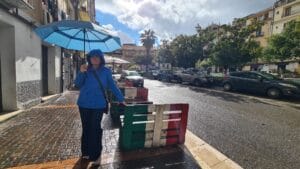
Lamezia Terme: The Blog That Nearly Didn’t Happen – By Andy
A2Z Wander | Our Blog A Rainy Arrival (and a Slight Hangover) Lamezia Terme almost didn’t get its own blog post. There’s only so many
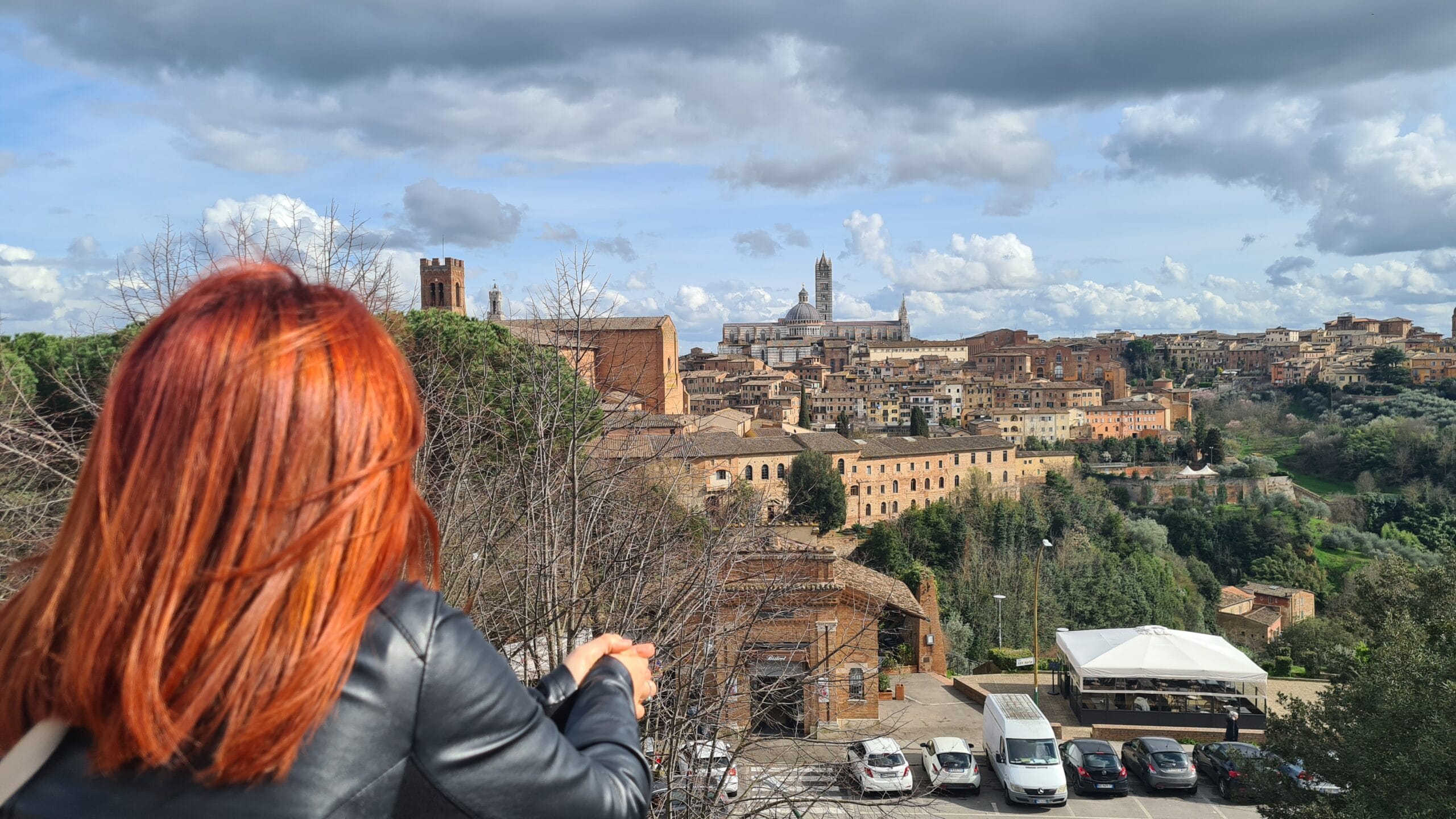
Some places announce themselves loudly. Others, like Siena, reveal their charm slowly—through sunlit piazzas, views that make you pause mid-step, and a history that lingers in every stone. We arrived early, with little expectation and no grand itinerary, and left completely captivated. This is the story of getting lost in Siena—and all the things we found along the way.
We’ve arrived early in Siena, earlier than we’d said we’d be and earlier than our official check-in time. The property manager says we can check-in early but we have to collect the keys from him round the corner. Off I trot to an osteria where a waiter waives at me from the front door. A waiter by day, property manager by night – one of these industrious multi-job gen-z types (fair play to him!).
“Sir, I can offer you a free room upgrade, would you like that?”
“Erm… (I wonder if this is one of the properties Zoe has specifically requested a room that has a particular balcony)… erm…”
“I think your wife will like it, it’s much better, you were in the budget room”
“Sure, ok, sounds great, thank you!”
What a stroke of luck! Not just a free room upgrade, if M&S did room upgrades, it would be an M&S upgrade. We’re staying in the first floor of a grand old palazzo, and our new room has a balcony that overlooks the Tuscan countryside and the rolling hills beyond. Not for the first time on this trip, or last I hope, the hairs on my neck are standing to attention. The type of view that inspired Dante, Machiavelli, Byron, Shelley and da Vinci to name a few.
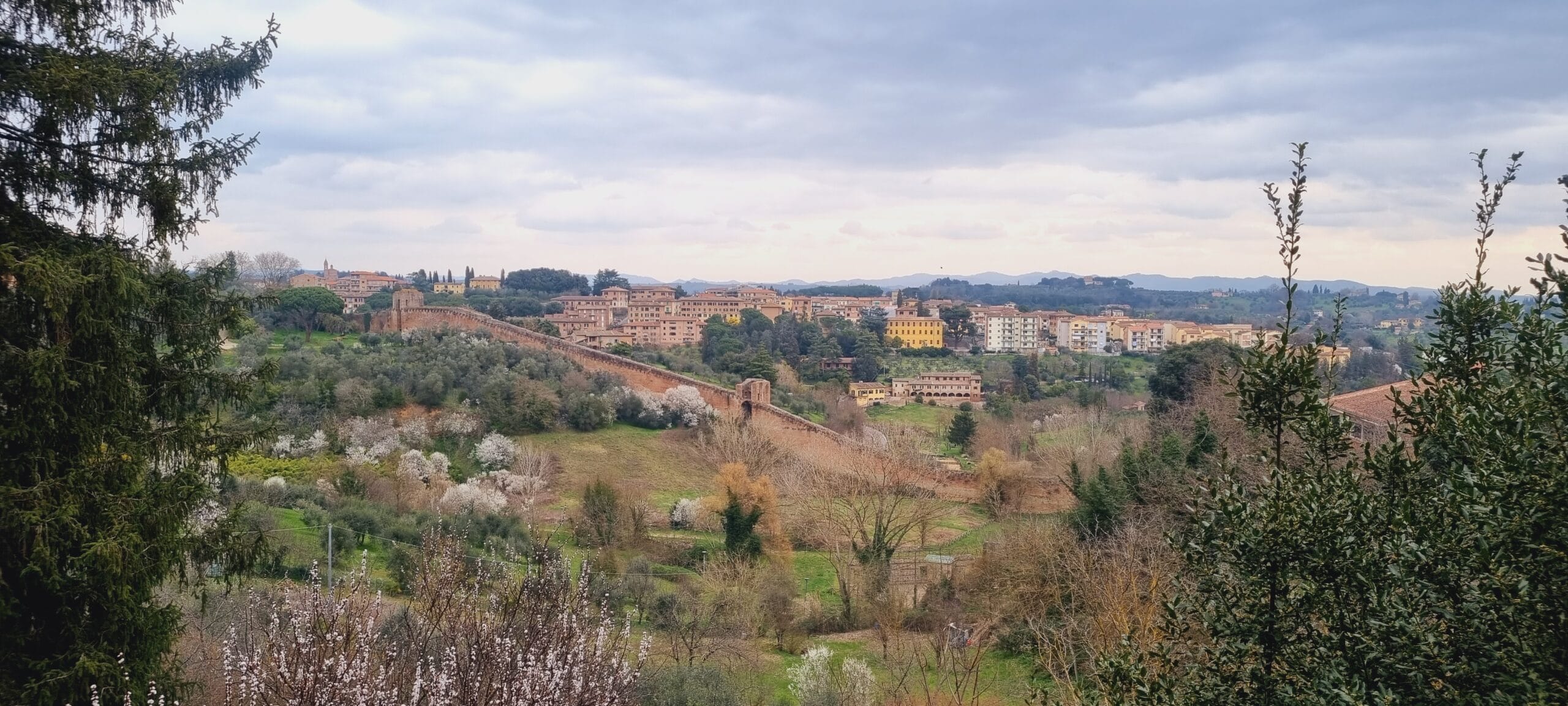
Even luckier, this wasn’t one of the accommodations Zoe was fussed about the specific room… result!
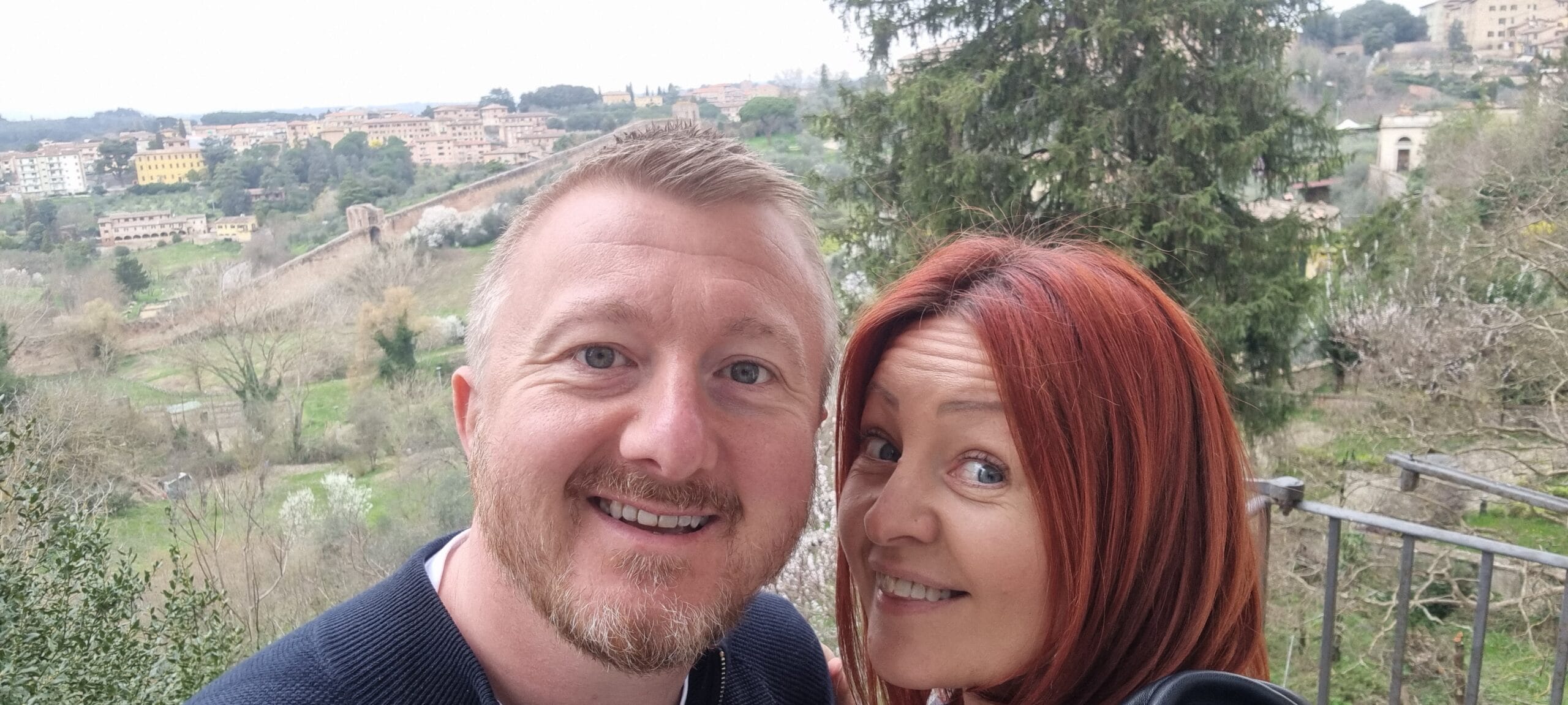
As we settled into our new view, I realised I had a confession to make. Before the trip, I don’t think I had ever heard of Siena. I’m not sure why, it just hadn’t really come into my consciousness, but I can tell you, now it’s a place that will never leave it again.
I found Siena to be utterly captivating. It’s a city seemingly frozen in time, famously well-preserved, with much of its medieval architecture intact. It was a powerful city-state during the Middle Ages, rivalled Florence in wealth and influence and is home to the oldest surviving bank in the world, Banca Monte dei Paschi di Siena, founded in 1472.
But probably best known for the Palio, a bareback horse race that takes place twice a year between the city’s districts, the contrade. The modern version, which first took place in 1633, is held in Siena’s historic town centre, Piazza del Campo.
As an ex-hockey player for a club that was one of many in a town, I know a little about local rivalry, but not almost 400 years of it. And this historic race and the contrade give Siena a vibe of a city in touch with its past.
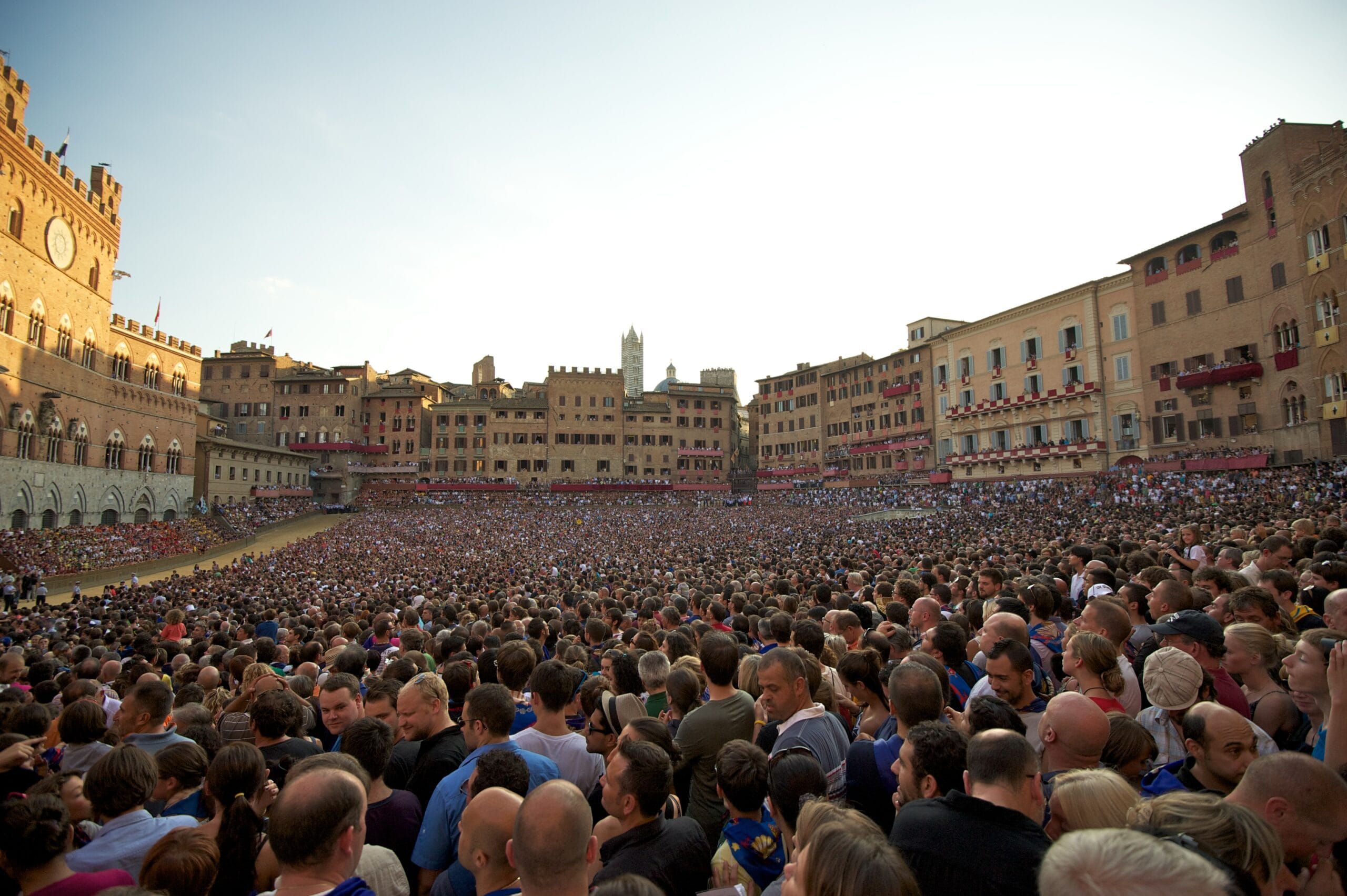
The palio only lasts for 90 seconds, but the build up and pageantry surrounding the race make it so much more than just about the 90 seconds. There’s a draw for which contrade will race, trial races, horse selection, a lottery to decide which horse will be for each contrade, and on the day of the race a great pageant that includes a squad of carabinieri on horseback, wielding swords, demonstrating a mounted charge around the track.
Spectators arrive early in the morning, they fill the centre of the town square, which is in eight segments banked down to a centre point in front of the Palazzo Pubblico, making for a unique viewing experience inside the track.
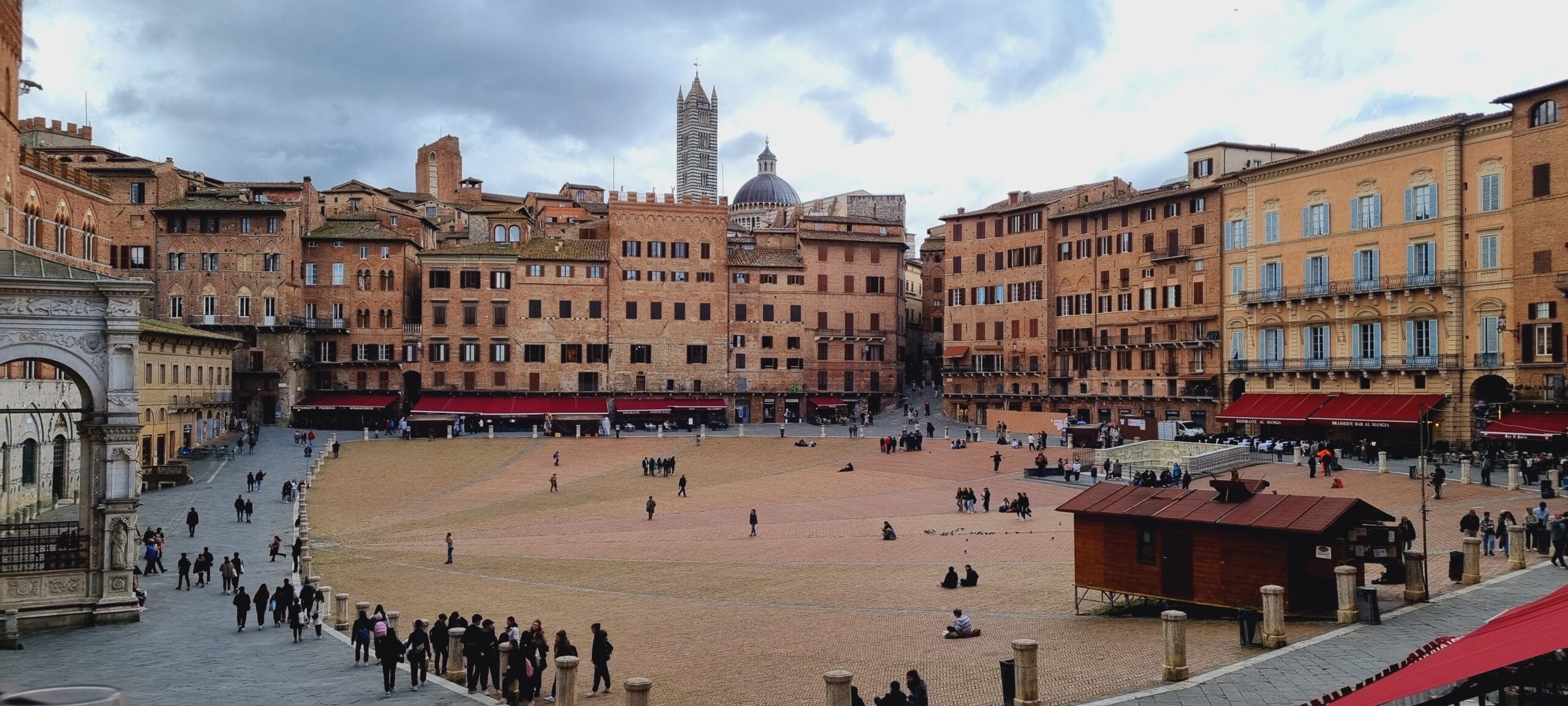
An explosive charge echoing across the piazza signals to the thousands of onlookers that the race is about to begin. Nine horses, in an order decided by lot, enter the starting space. The tenth, the rincorsa, waits outside. When the rincorsa finally enters the space between the ropes the starter activates a mechanism that instantly drops the front rope. This process can take a very long time, as deals have usually been made between various contrade and jockeys that affect when the rincorsa moves.
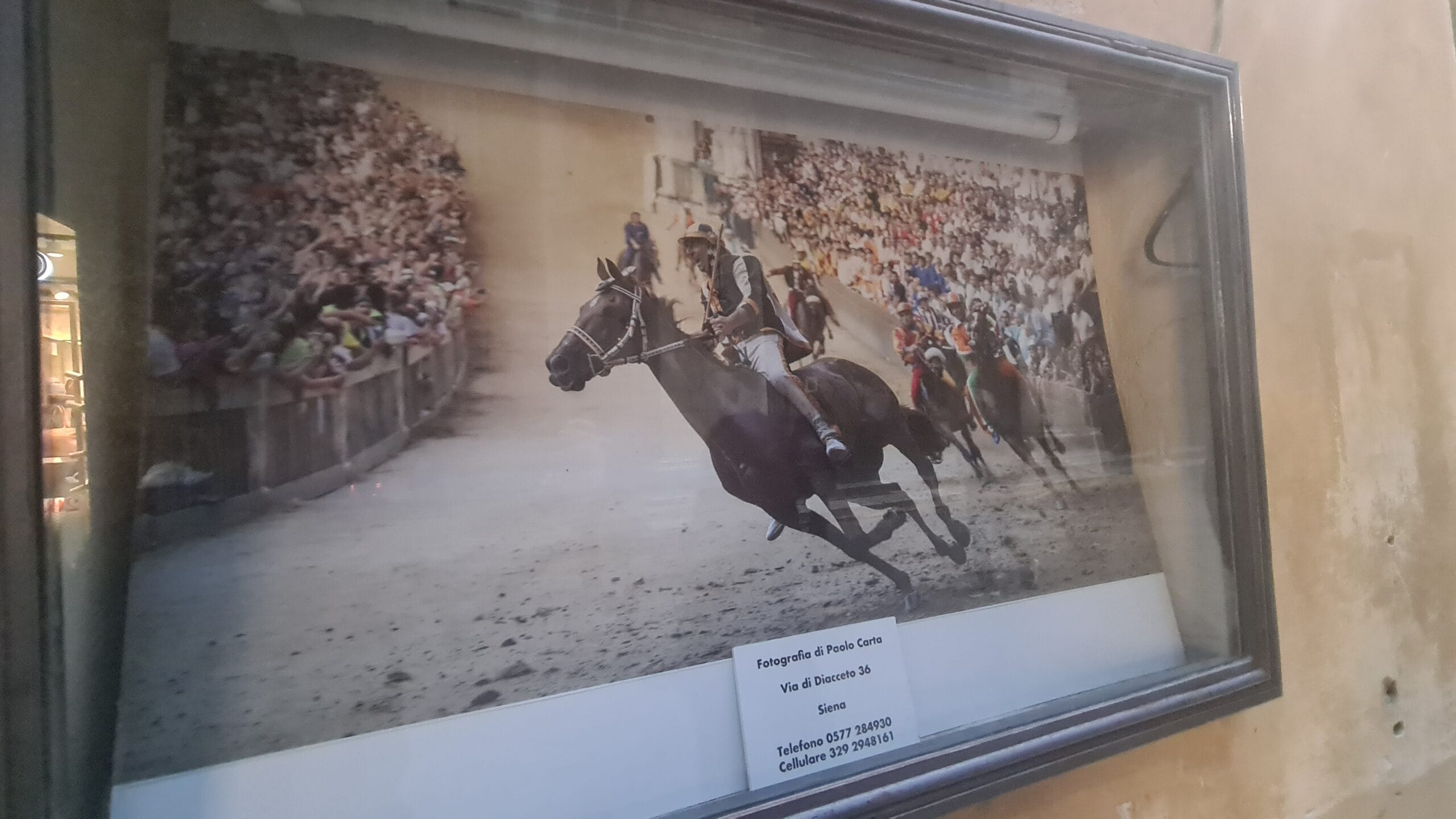
The riders are allowed to use their whips not only for their own horse, but also for disturbing other horses and riders. The Palio is won by the horse who represents his contrada, and not by the jockeys. The winner is the first horse to cross the finish line—a horse can win without its rider and the loser in the race is considered to be the contrada whose horse came second, not last.
The winner is awarded a banner of painted silk, or palio, which is hand-painted by a different artist for each race. The celebrations after the victory are so extreme that the winners ceremony is usually quite instantaneous. It marks the first moment of a months-long celebration for the winning contrade.
While we are not here at the correct time of year to see this historical event, it doesn’t stop us enjoying the same view some spectators take up. Around the Piazza del Campo, above the restaurants and cafes lining the outside, there are viewing balconies from which many choose to watch the palio avoiding the crush in the centre of the piazza. A couple of the cafes have their viewing balconies open all year round. We sat there and enjoyed a glass of wine, coffee and bruschetta with olive tapenade. The steps and doorway to get to the viewing balcony is laughably small and awkward, just adding to the whole whimsy of the event.
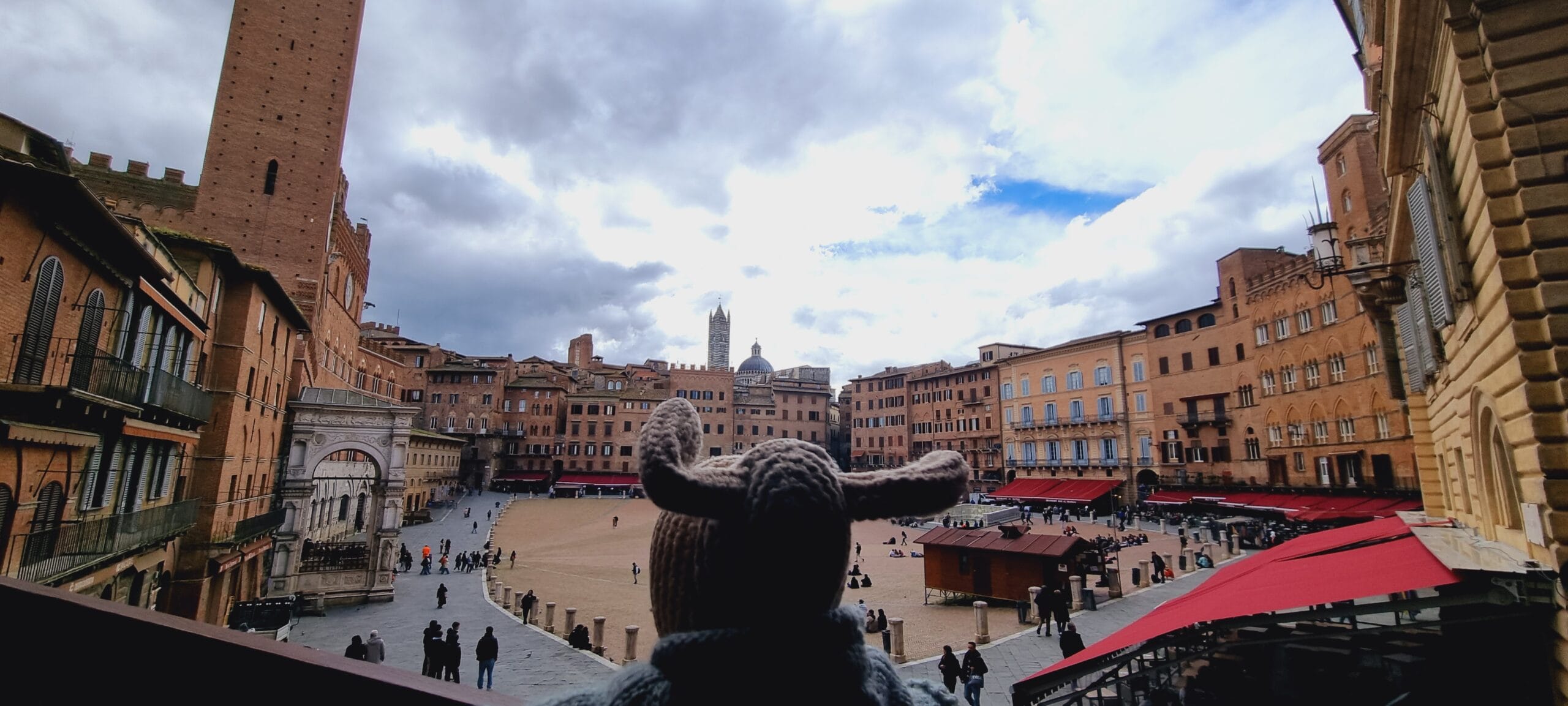
The noise of the occasion must be deafening. Thousands crammed into the centre of the piazza, hundreds more on the viewing balconies and hanging from windows each cheering for their contrade’s horse. Often contrade will take more joy from their fiercest rivals not winning than if they had won the palio. Therefore, it may be of no surprise that violence often breaks out between rival contrade.
I doubt there’s many sporting atmosphere’s quite like it, not even the North London derby.
When we enter Piazza del Campo for the first time, it’s the smell that hits us first. We follow our noses to the small wooden frittelle hut. This hut is run by a family, the Savellis, who have been making frittelle in the city of Siena for four generations.
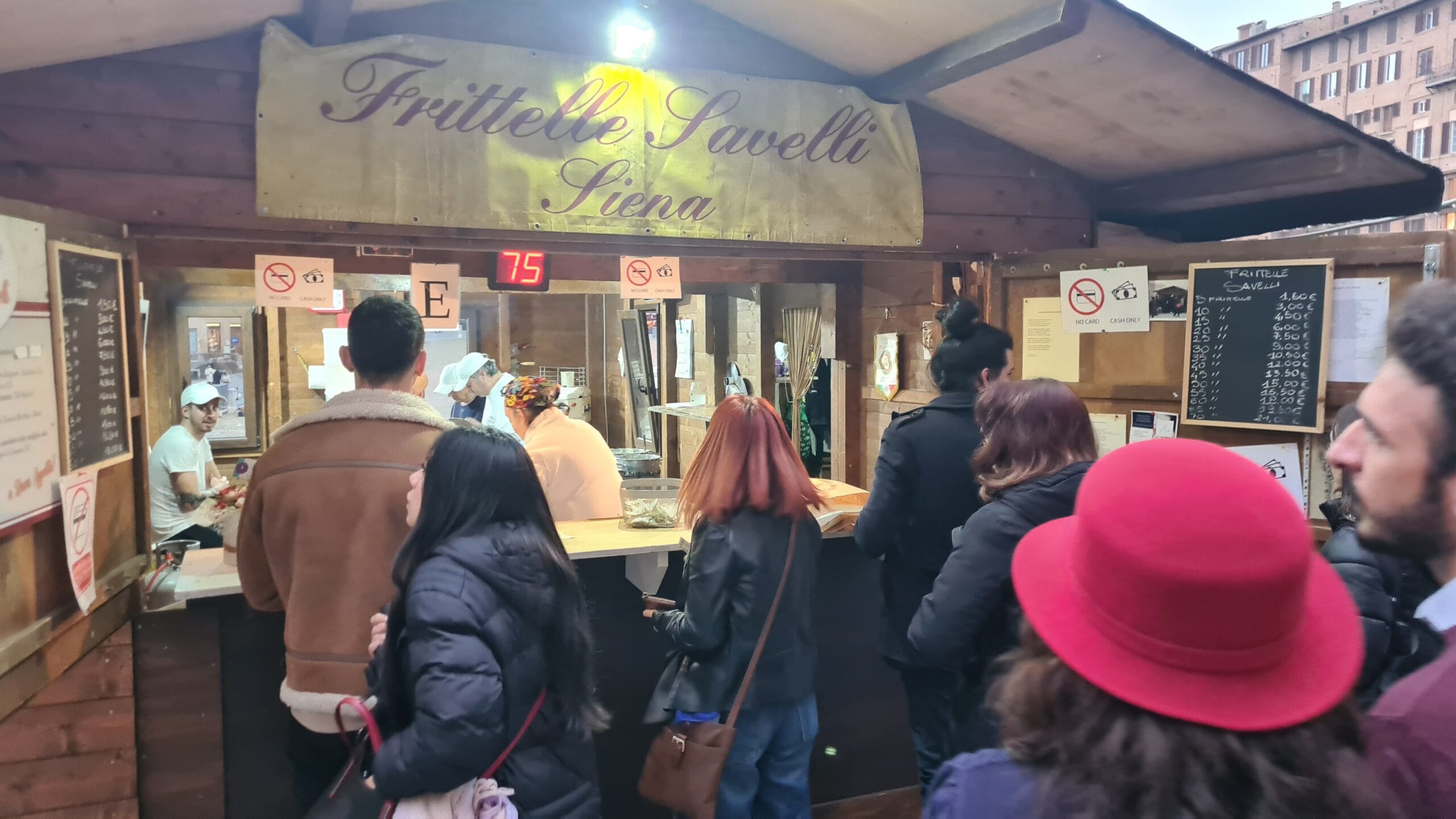
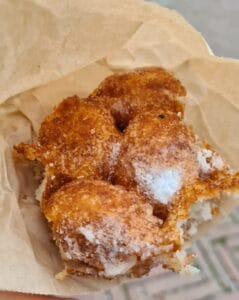 Frittelle are doughnut-like-fritters – sweet, fried balls of rice dough laced with orange rind. The outside is dusted in sugar and satisfyingly crunchy; the middle light yet starchy enough to let you know you probably shouldn’t have too many. And through it all that lovely hint of citrus.
Frittelle are doughnut-like-fritters – sweet, fried balls of rice dough laced with orange rind. The outside is dusted in sugar and satisfyingly crunchy; the middle light yet starchy enough to let you know you probably shouldn’t have too many. And through it all that lovely hint of citrus.
The stall appears in the square only once a year, from 30 January until 20 March, the day after Father’s day in Italy (San Giuseppe). Incredibly, the Savelli family are not bakers by trade, they each have jobs outside of providing this wonderful street food delicacy. For 2 months of the year they come together to run the stall using the same recipe that’s been passed down for over 80 years.
They’re so good, we return for more the following day. We know we shouldn’t, but these really are the sweetest of treats, a reward for all the steps we’ve walked.
With Zoe working two mornings of the three we’re in Siena, it gives us a little time to slow down our sightseeing and me a chance to run knowing I won’t be adding 20,000 steps on top.
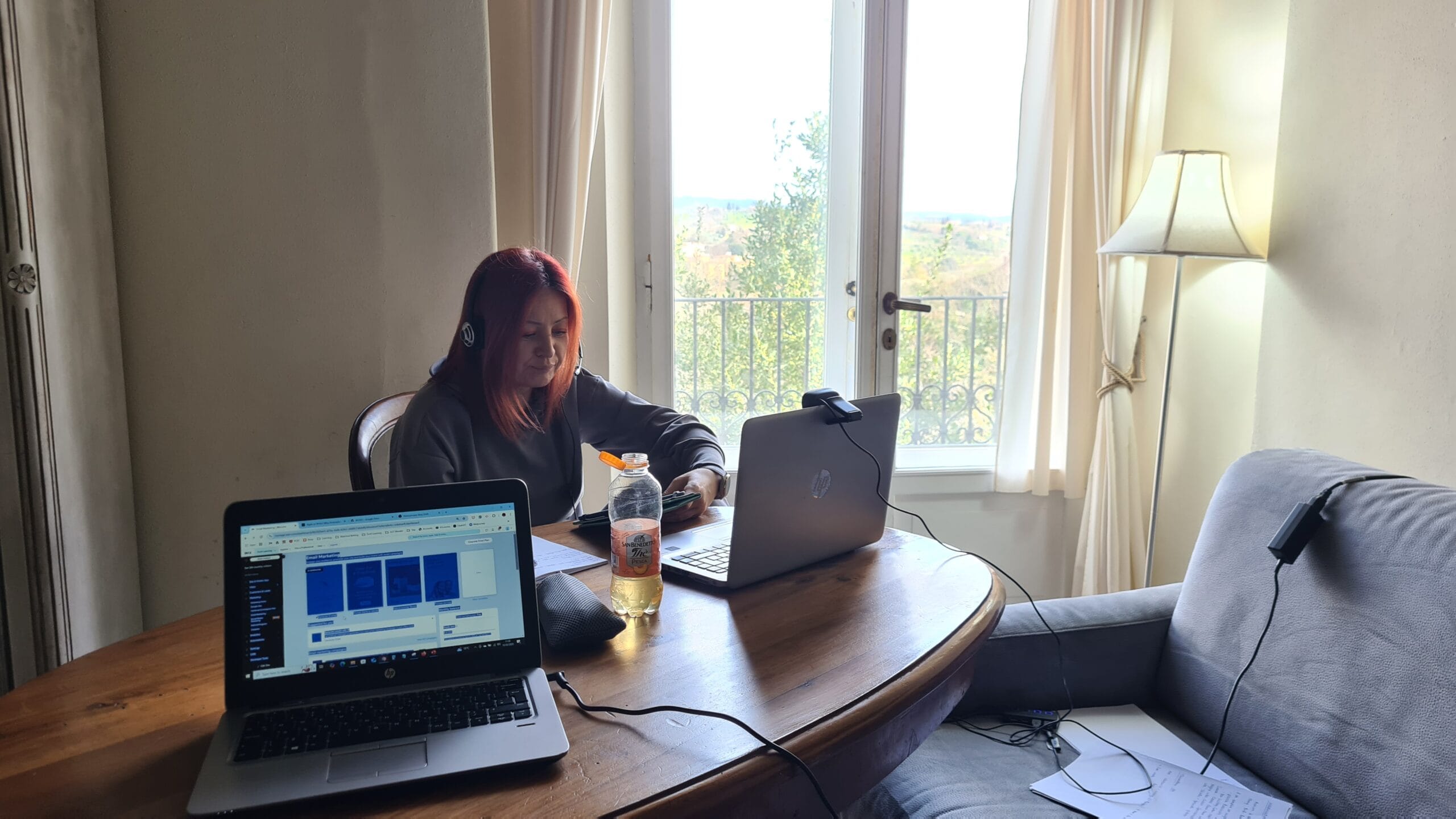
Having carefully selected a running route from Strava, I stepped out onto the cobbled streets of this ancient city confident that I had some idea of where I was going from the little exploring we did the night before.
However, my sense of direction and the GPS frailties of being in ancient narrow streets meant that my route rather haphazardly wove around the city like a game of snakes on an old Nokia. But, I made it to the Medici Fortress, taking in the spectacular views back at the historic centre and the cathedral.
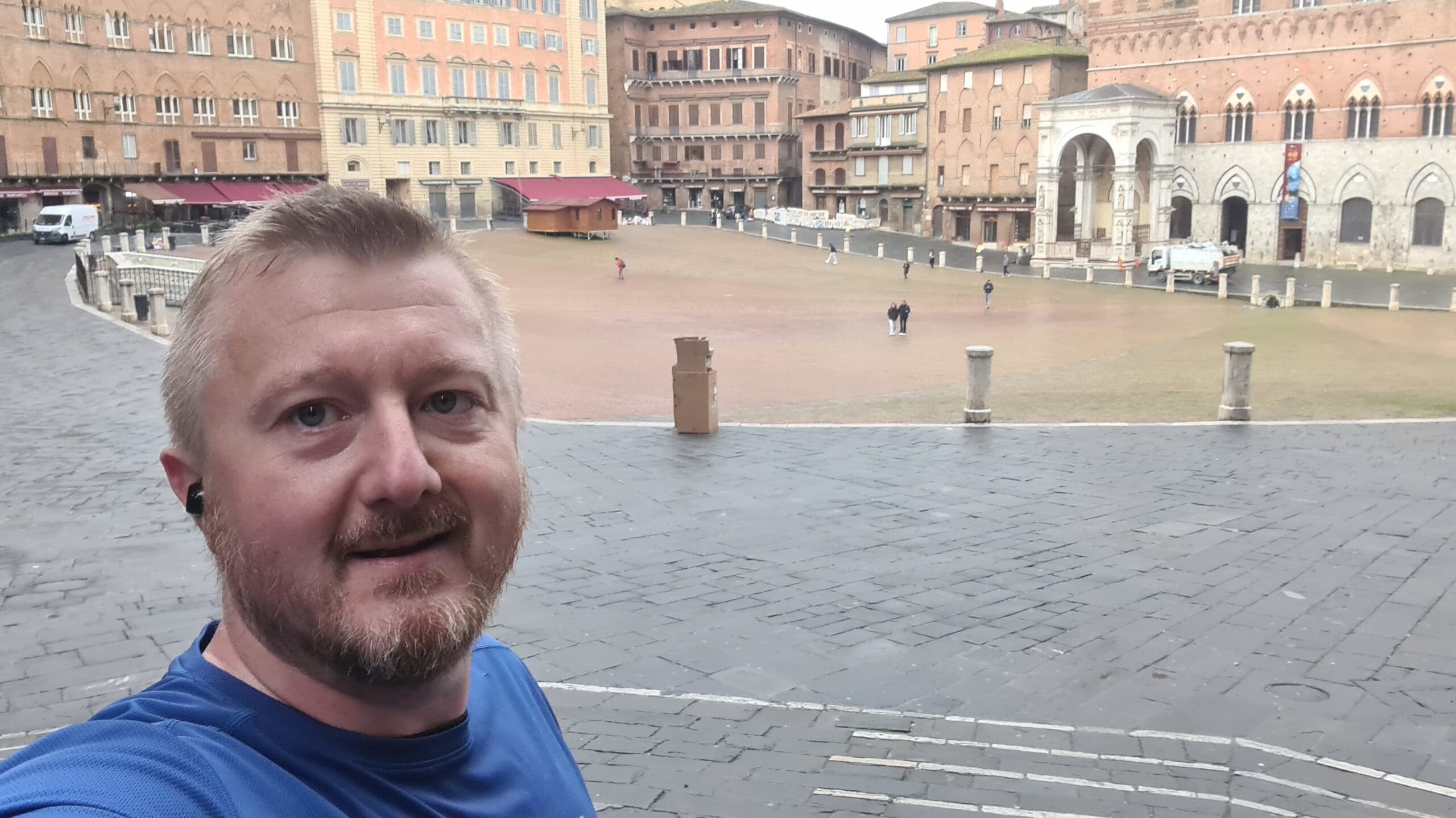
Getting back from the Medici fortress should’ve been straight forward, we walked it the next day in just 10 minutes. However, it took me roughly 67 wrong turns and about 25 minutes. Admittedly, this was the first time I had tried to follow someone else’s route and GPS was lagging quite a bit behind but still, my sense of direction and understanding of the geography of Siena really did fail.
A little more exhausted and later than I had planned I get back to our palazzo to find that Zoe hadn’t waited for me to go to breakfast, but could highly recommend the orange cake. Italians and their cake for breakfast!
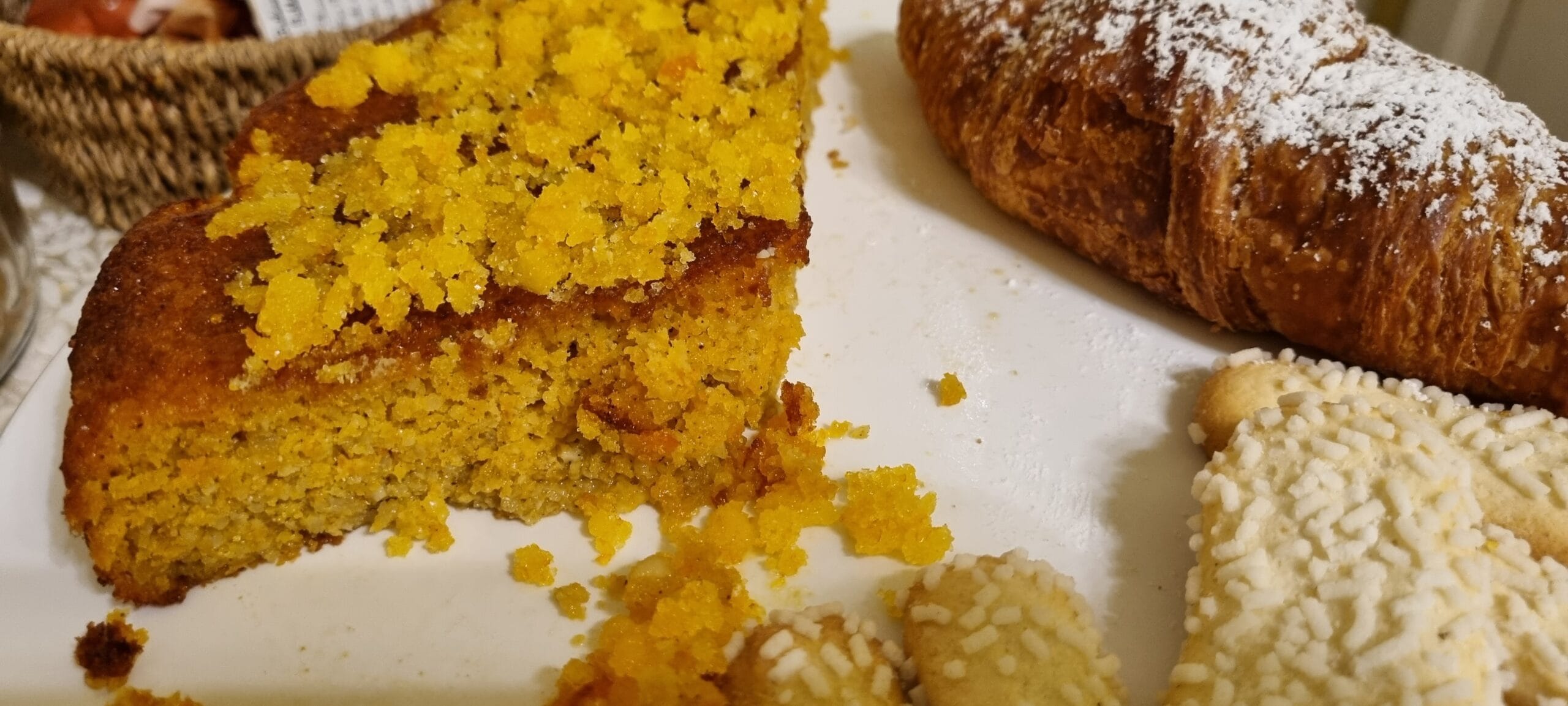
After a coffee and the last few crumbs of orange cake, we set out to explore Siena’s showstopper: the cathedral.
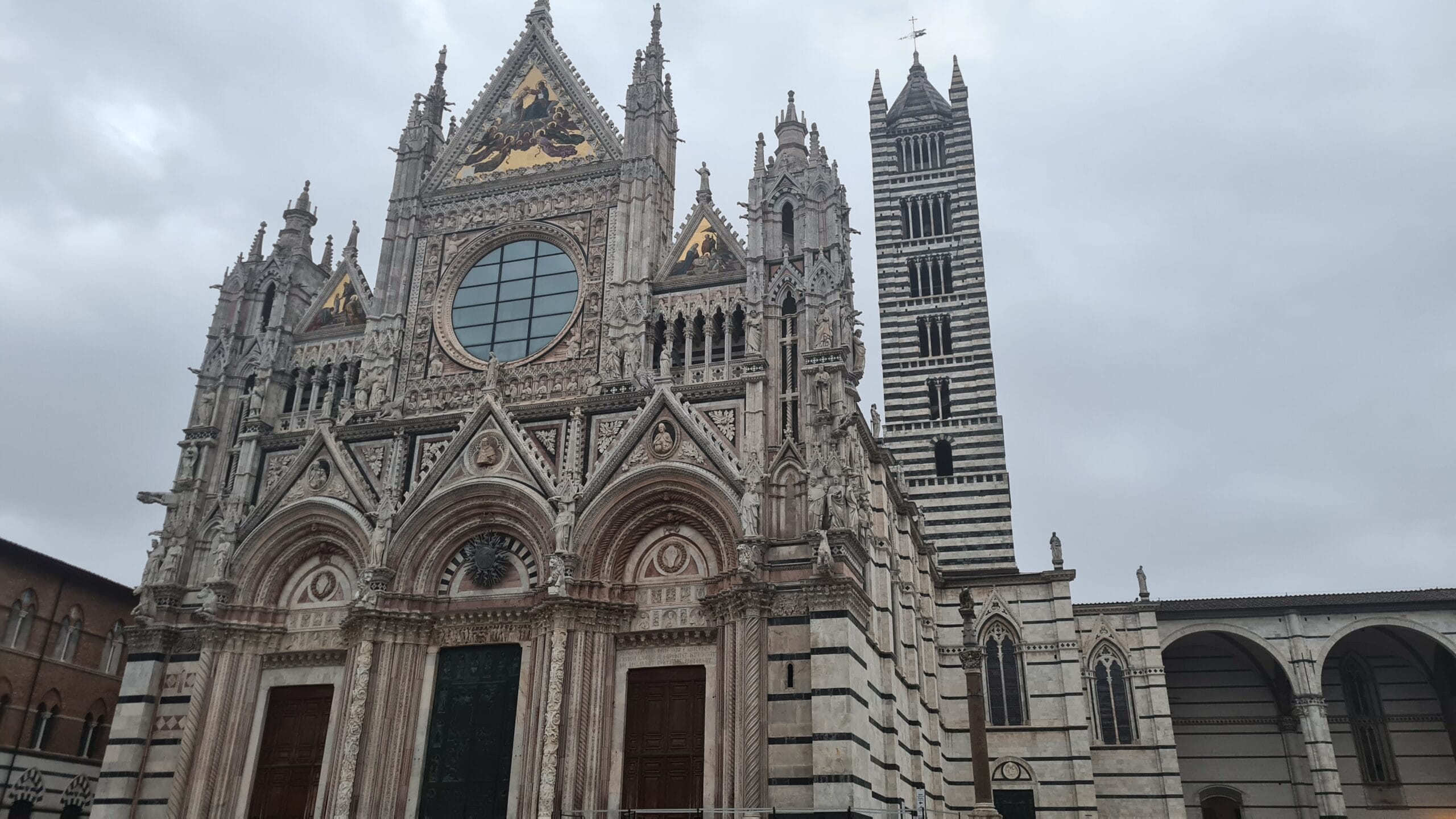
The cathedral complex in Siena is staggering. Even in the rain.
As we reached the cathedral for the first time, the heavens opened — an appropriately dramatic entrance for such a masterpiece. The first sprinkling from a cloud that would apparently follow us for quite a bit of our trip.
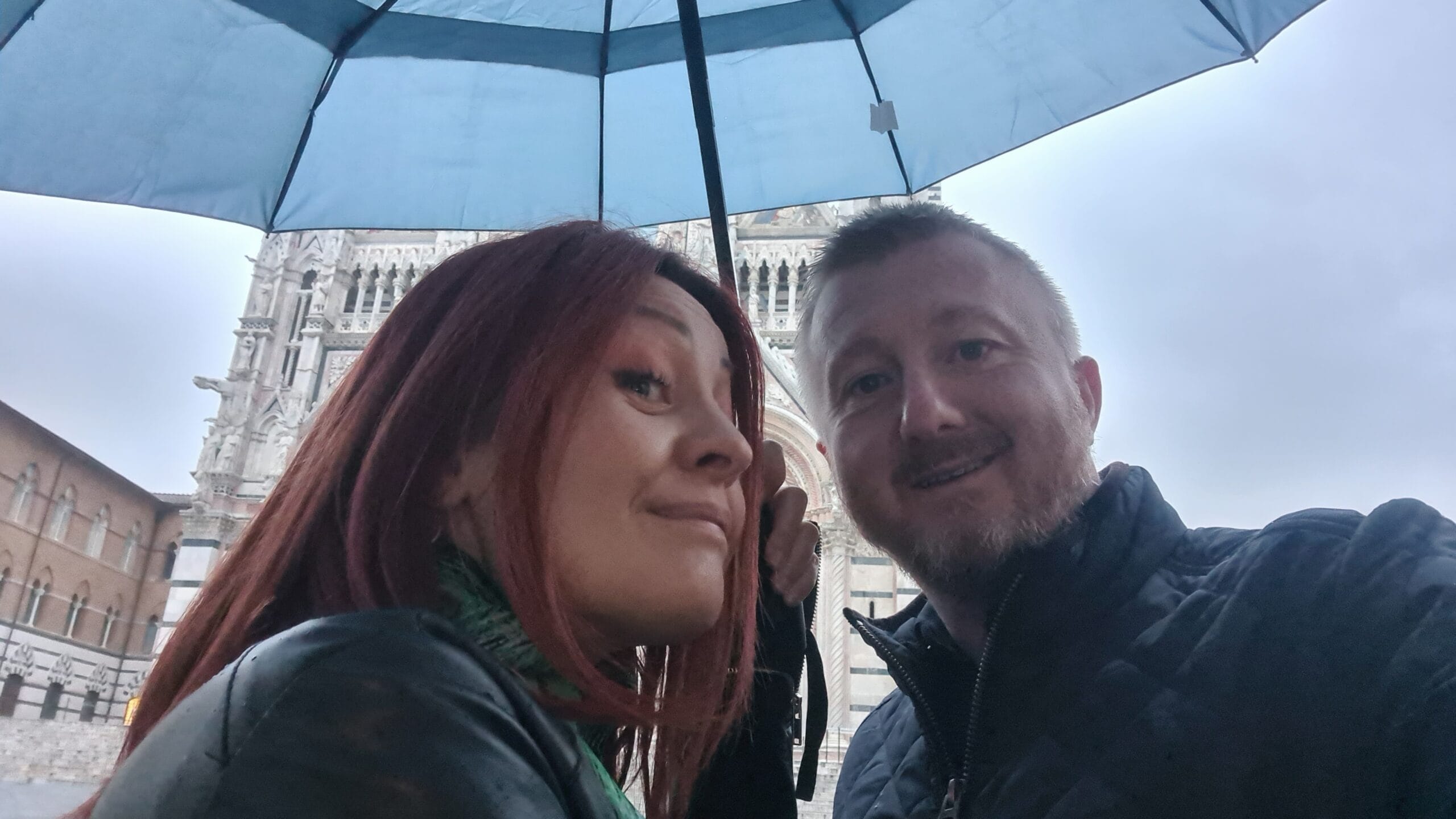
The facade to Siena’s cathedral is breathtaking, truly both grand and ornate. A masterpiece of Gothic architecture, the cathedral is richly decorated with white and dark green marble and intricate carvings. As we stand admiring the beauty, a fellow Englishman walks around the corner to glimpse the cathedral for the first time and exclaims “that’s fucking amazing”… the Italians would perhaps prefer us to say it a little more eloquently, but he’s not wrong.
The cathedral ticket we bought allowed access to the entire complex, which we can highly recommend.
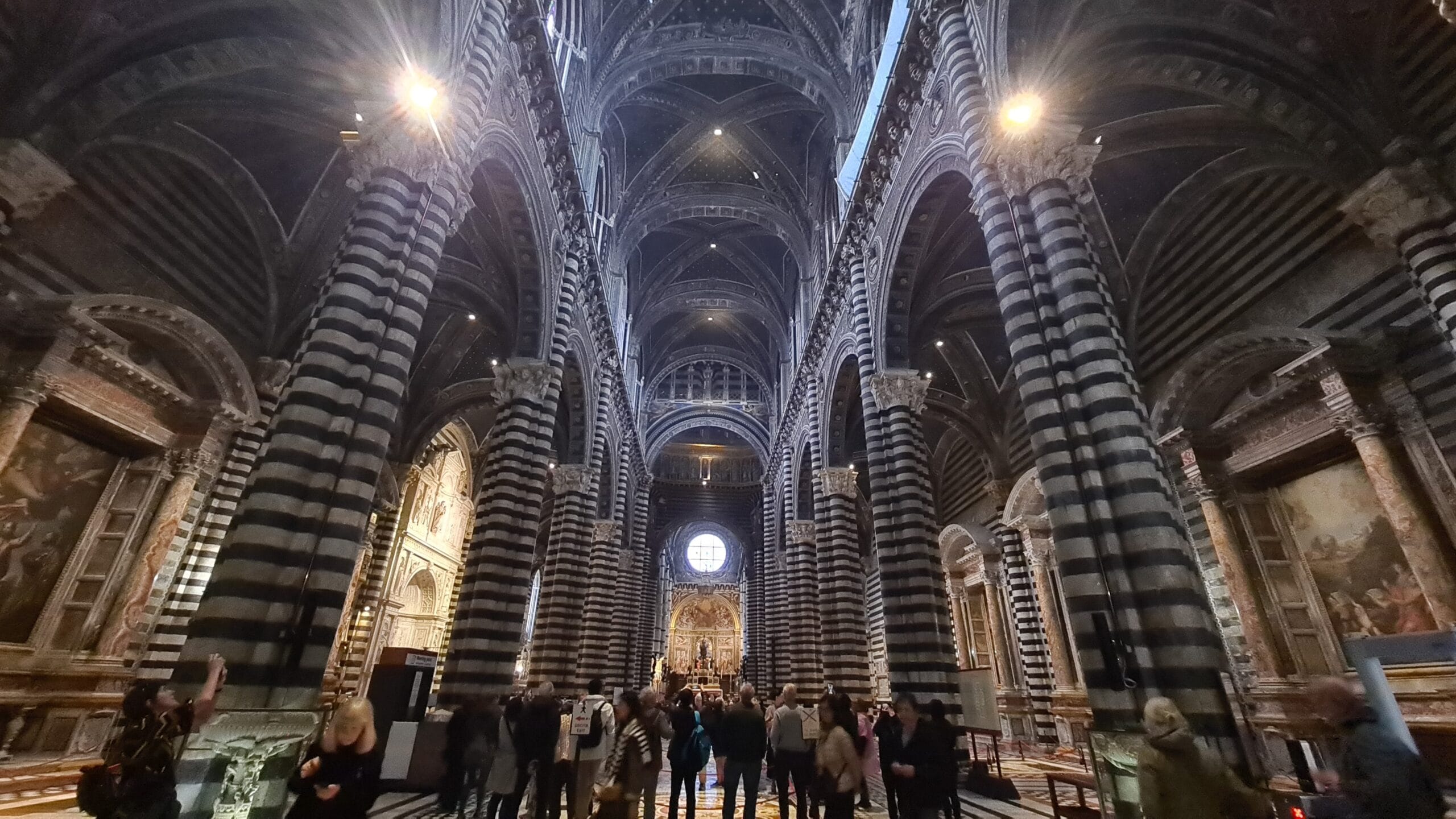
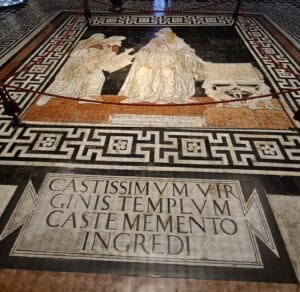 The cathedral is decorated with bold black and white marble stripes—both inside and out— symbolising the colours of Siena’s legendary founders, Senius and Aschius. According to legend, they rode into the region on a black and a white horse.
The cathedral is decorated with bold black and white marble stripes—both inside and out— symbolising the colours of Siena’s legendary founders, Senius and Aschius. According to legend, they rode into the region on a black and a white horse.
The floor of Siena Cathedral is one of the most ornate in the world. It consists of 56 inlaid marble panels created over nearly 600 years, from the 14th to the 19th century. The designs depict biblical scenes, allegories, and classical sibyls (female prophets), blending religious and pagan themes.
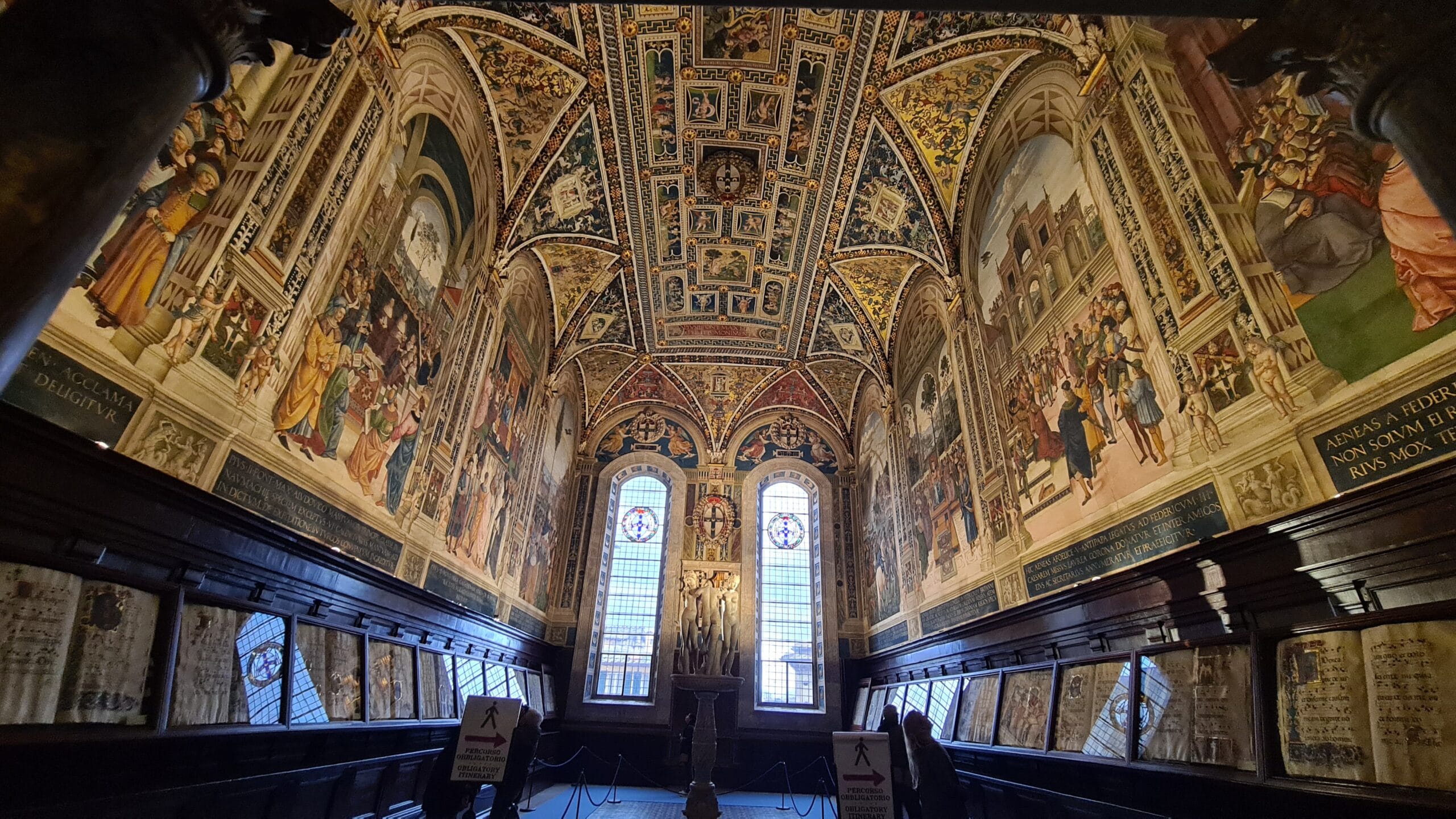
The cathedral houses works by both Donatello and Michelangelo but perhaps more spectacular is the Piccolomini Library. Off to the left of the nave of the cathedral, the Library is a riot of colour and Renaissance splendour. Commissioned by Cardinal Francesco Piccolomini, who later became Pope Pius III, it was built to honour his uncle, Pope Pius II. The walls are covered in vivid frescoes by Pinturicchio, assisted by a young Raphael. The ceiling is a masterpiece in itself, and the library holds precious illuminated manuscripts with intricate illustrations.
Zoe is rarely left speechless, but the colour and intricacies of this room did the job. Perhaps not one to take as inspiration for the front room of our next home, but to be admired nonetheless.
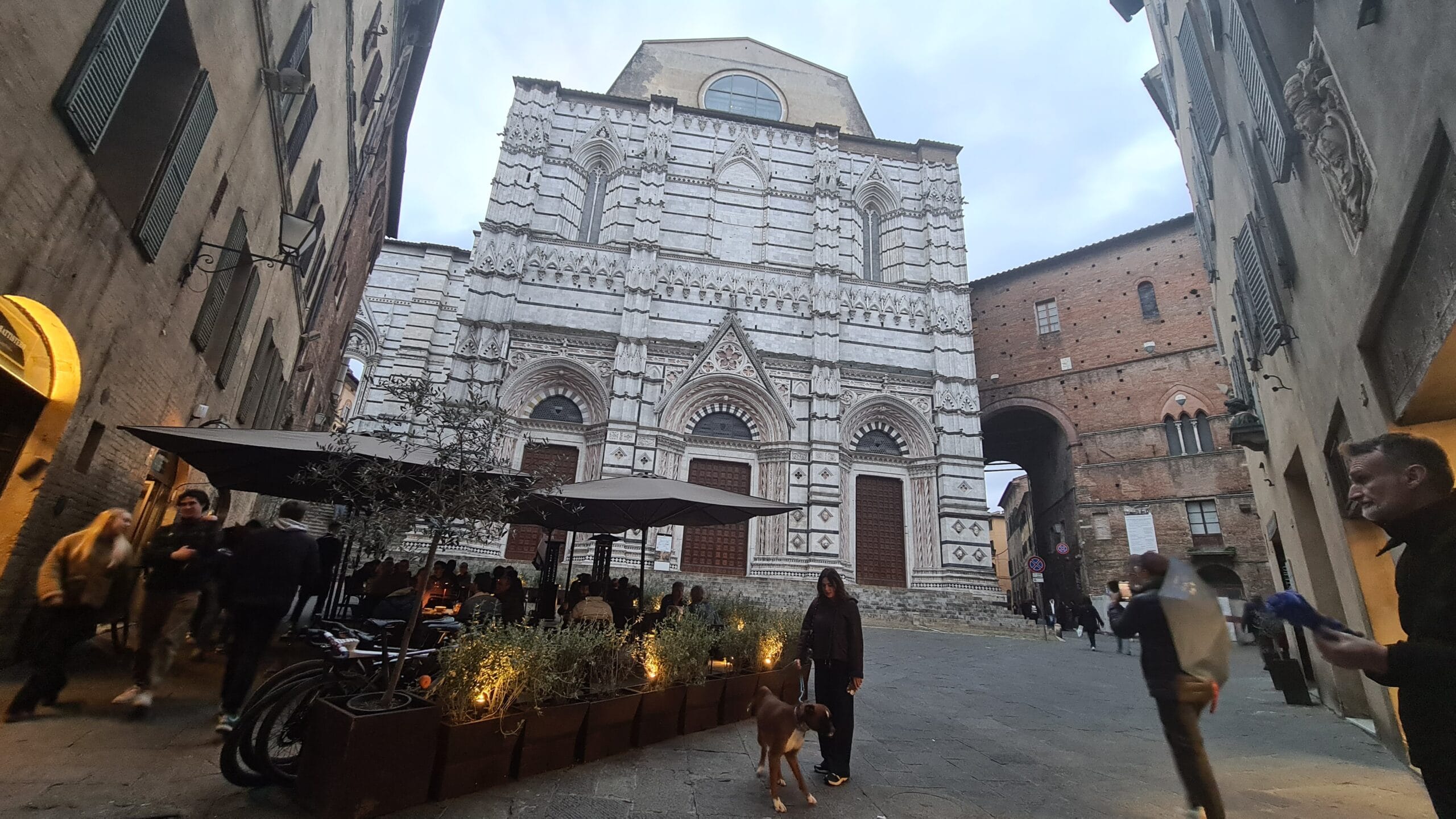
Included in our ticket is entrance to the baptistry. Unlike Florence or Pisa, the baptistry is not a separate building, it’s located underneath the eastern bays of the choir of the cathedral. This separate entrance, and massive marble staircase that tracks around the cathedral gives the whole complex an extremely grand feel.
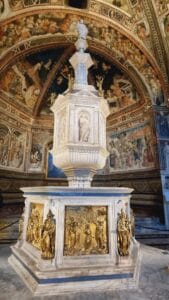 The main attraction in the baptistry is the hexagonal baptismal font, containing sculptures and reliefs by Donatello, Jacopo della Quercia and Lorenzo Ghiberti.
The main attraction in the baptistry is the hexagonal baptismal font, containing sculptures and reliefs by Donatello, Jacopo della Quercia and Lorenzo Ghiberti.
Tucked away beneath the cathedral, near the baptistry, lies one of its most astonishing secrets—the crypt, a hidden chamber that remained lost for centuries until its rediscovery in 1999.
While medieval texts had long hinted at the existence of a crypt, no one knew exactly what had survived the passage of time. That mystery was solved during a routine excavation, when archaeologists unearthed a remarkably well-preserved space that had been intentionally filled in with earth and rubble, likely in the early 15th century.
What had been buried for centuries turned out to be extraordinary. The crypt, dating back to the late 13th century, is adorned with a cycle of frescoes, still vivid in colour despite their long burial. Covering the walls and the two central pillars, these forty-five painted scenes bring to life moments from both the Old and New Testaments.
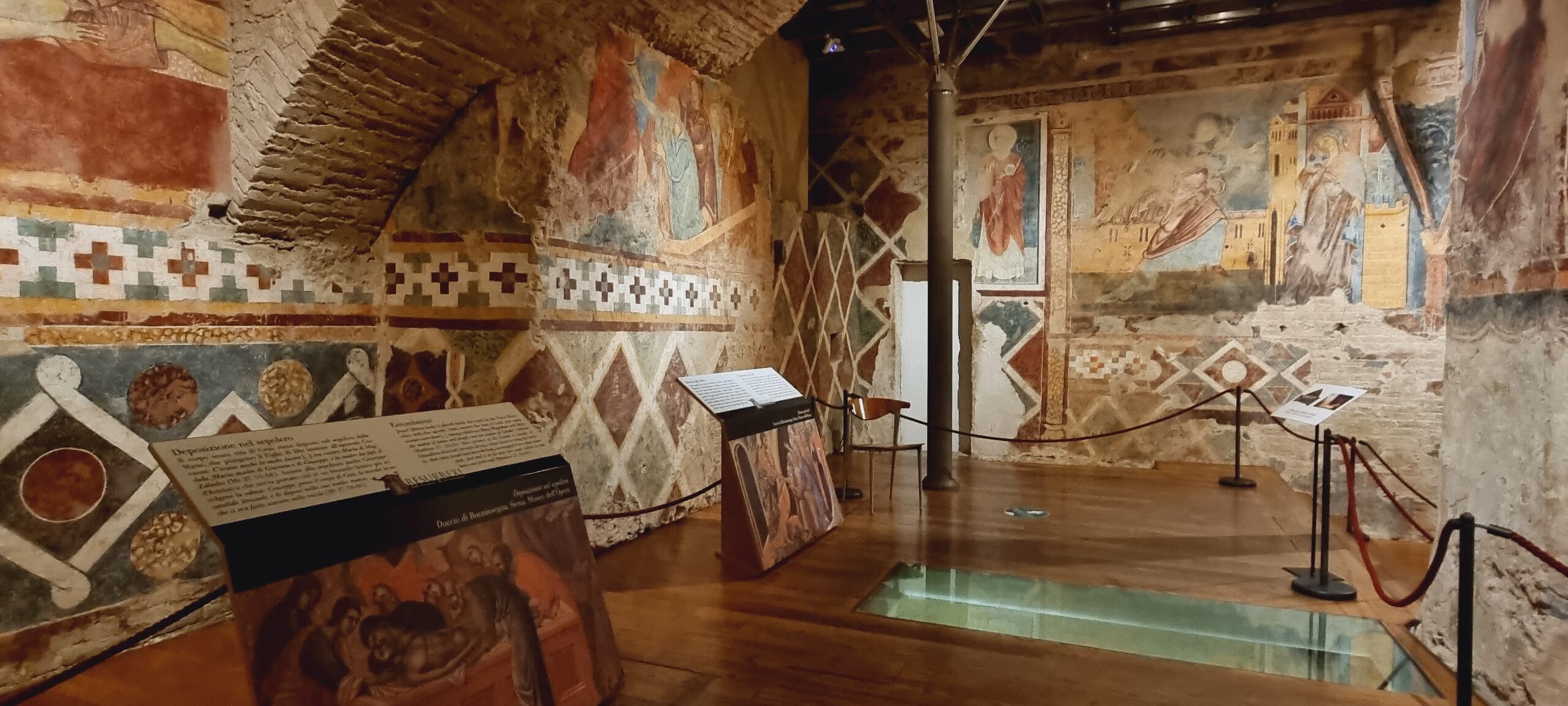
Visiting the crypt today feels like stepping directly into Siena’s medieval soul—a rare chance to see art that hasn’t been restored, retouched, or tampered with over time. It’s raw, it’s real, and it’s one of the most evocative parts of the entire Duomo complex.
Just beside the grandeur of Siena’s Duomo lies an equally awe-inspiring sight—not for what it is, but for what it might have been. This is the Duomo Nuovo (New Cathedral), the remains of an ambitious expansion project that tells a dramatic tale of vision, pride, and unexpected tragedy.
In the mid-14th century, Siena was at the height of its power and prosperity, rivalled only by Florence. Fuelled by wealth, artistic achievement, and civic pride, the city’s leaders envisioned a cathedral so vast and magnificent that it would surpass all others in Europe. The plan? To transform the existing Duomo into just the transept of a new, colossal structure that would stretch far beyond the current footprint.
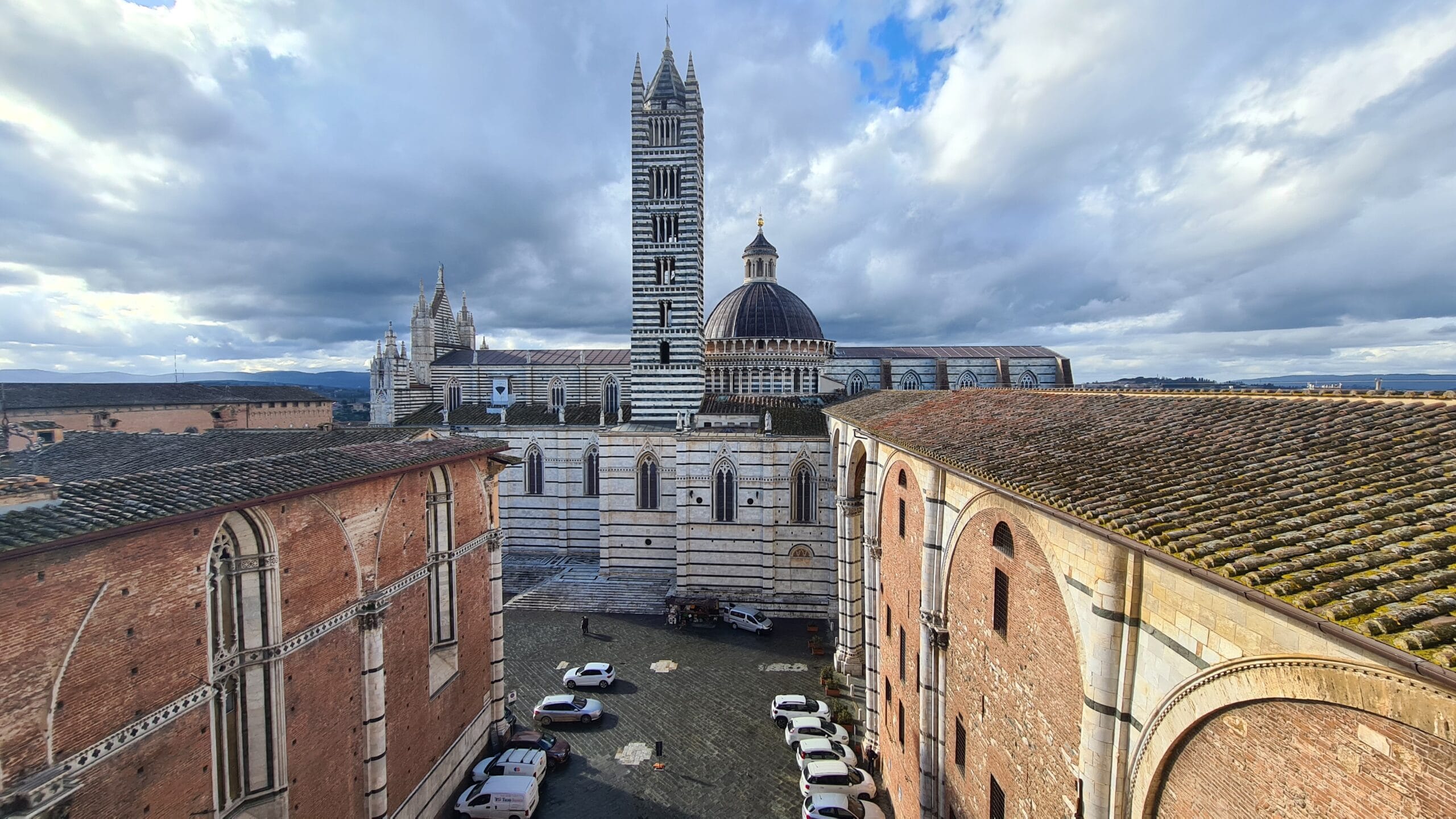
Work began in earnest around 1339, and the foundations of the new nave, aisles, and a grand façade were laid. However, fate had other plans. In 1348, the Black Death swept through Siena, decimating the population and bringing construction—and much of the city’s ambition—to a sudden, shattering halt. Financial ruin and political instability followed, and the dream of the world’s largest cathedral was quietly abandoned.
Today, what remains is a hauntingly beautiful architectural fragment: the massive facciatone, or unfinished façade wall, part of the would-be nave. This incomplete structure stands as a powerful reminder of both Siena’s grand aspirations and the fragility of human plans.
But it’s far from just a relic. You can climb to the top of the Facciatone, now part of the cathedral’s museum complex, for one of the most breathtaking panoramic views of Siena and the rolling Tuscan countryside. From up there, it’s easy to imagine what might have been—and to admire more what still is.
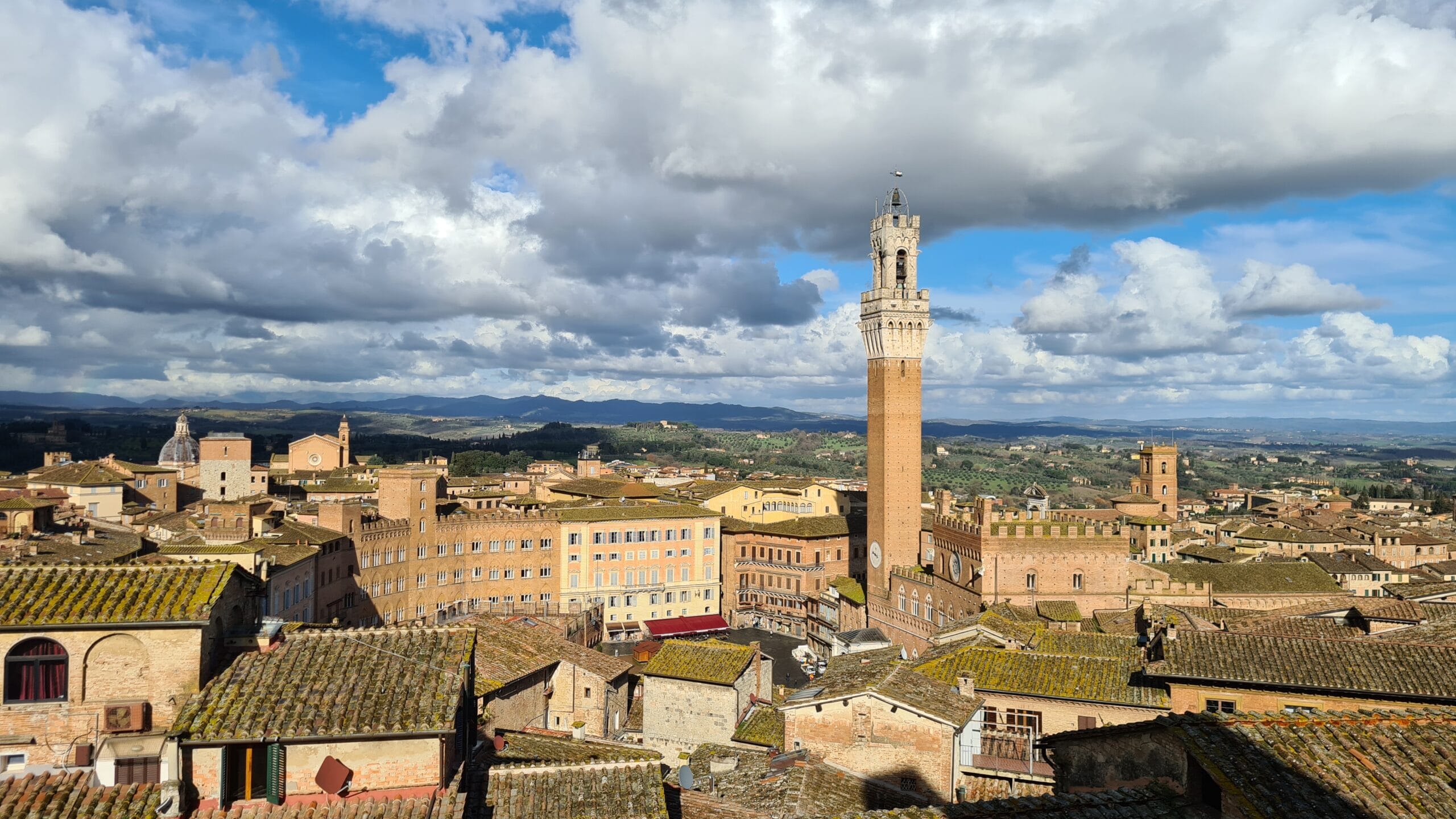
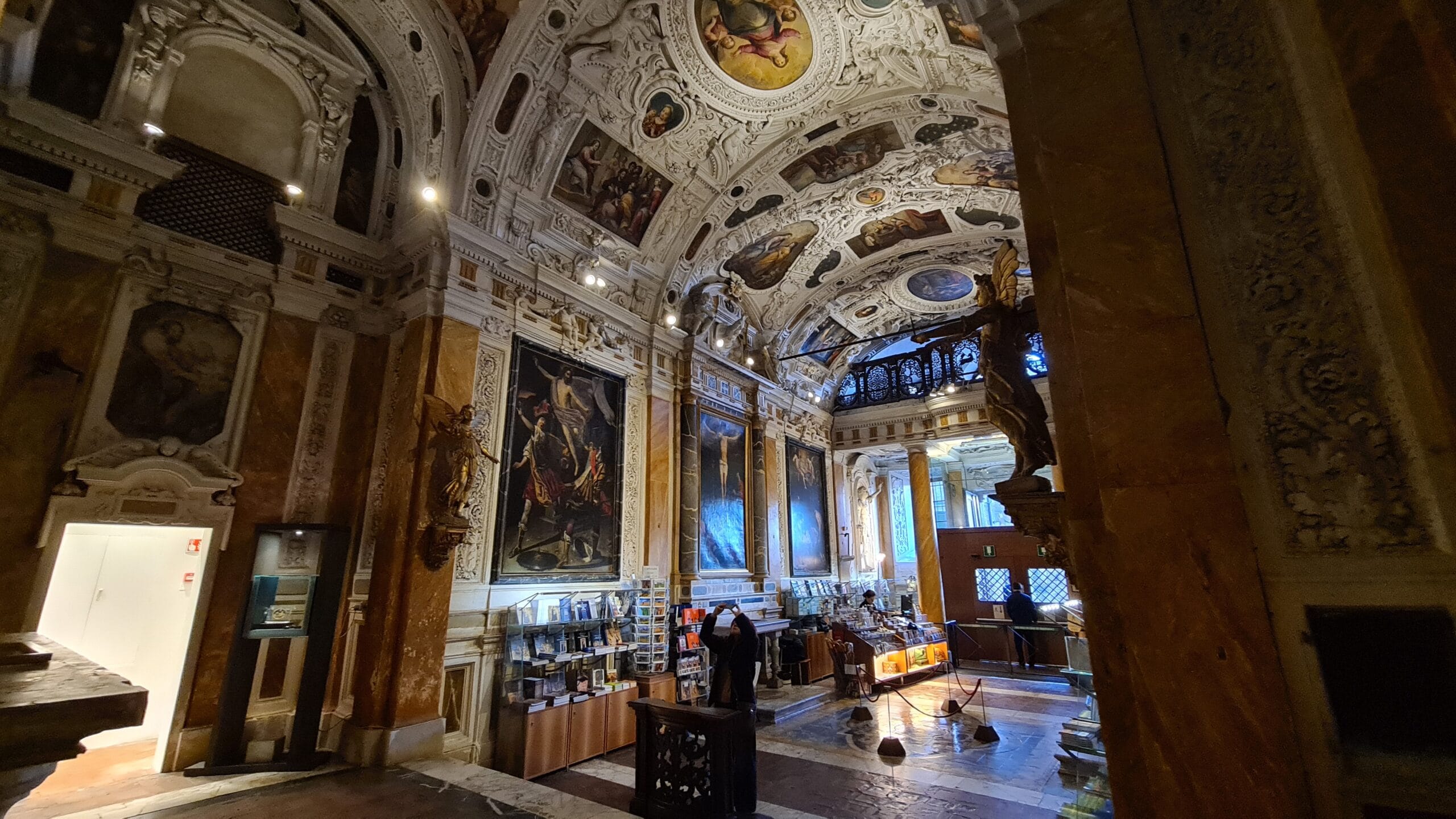
A photo of the gift shop provided above! Know of a prettier one?
The cathedral complex takes at least 3 hours to go round every element and you tend to build up an appetite for some good hearty Tuscan food. And so we go in search.
Google Maps and specifically the information regarding restaurant opening times again leads us to multiple locations only to be disappointed. We walk past what looked like it could be a perfect little vineria but despite a sign outside saying they were open, they weren’t. We decide it’s not our night. And then it started to rain.
A little lost, hungry and now getting wet, we find ourselves back at the cathedral having gone full circle. We stop briefly again to admire the cathedral’s facade, this time we’re amused by a photographer who has placed his camera on a timer and is running to and from his companion standing about 20 metres away under an umbrella. After about 5 takes the couple fall about laughing and decide they have their photo.
Watching this lesson in photography unfold wasn’t long, but turned out to be just the right amount of time. As we walked back past the end of the street the vineria was on, I spotted the lights were on. Our luck had turned.

Vineria Tirabusciò was right up our street, a snug, warm wine bar offering organic wines and a very small menu of Tuscan dishes.
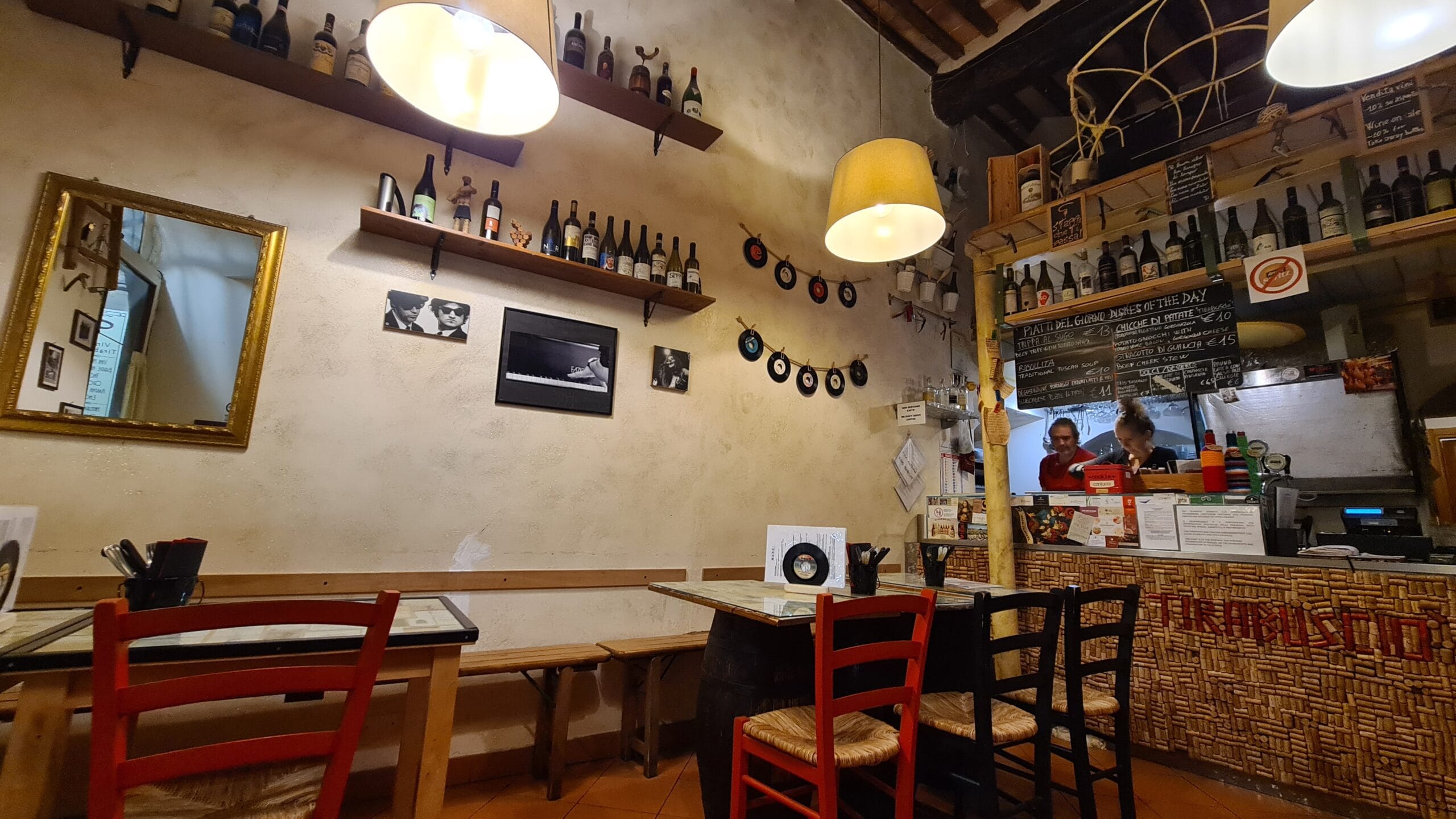
We shared a selection of local cheeses to start, Zoe then had the Ribollita, a very hearty traditional Tuscan soup, and I went for the Stracotto di Guancia, beef cheek stew. Two dishes that give you a massive hug and somehow touch your soul. Simple, yet extremely tasty, with depths of flavour only obtained with long slow cookery and lots of love, and knowhow.
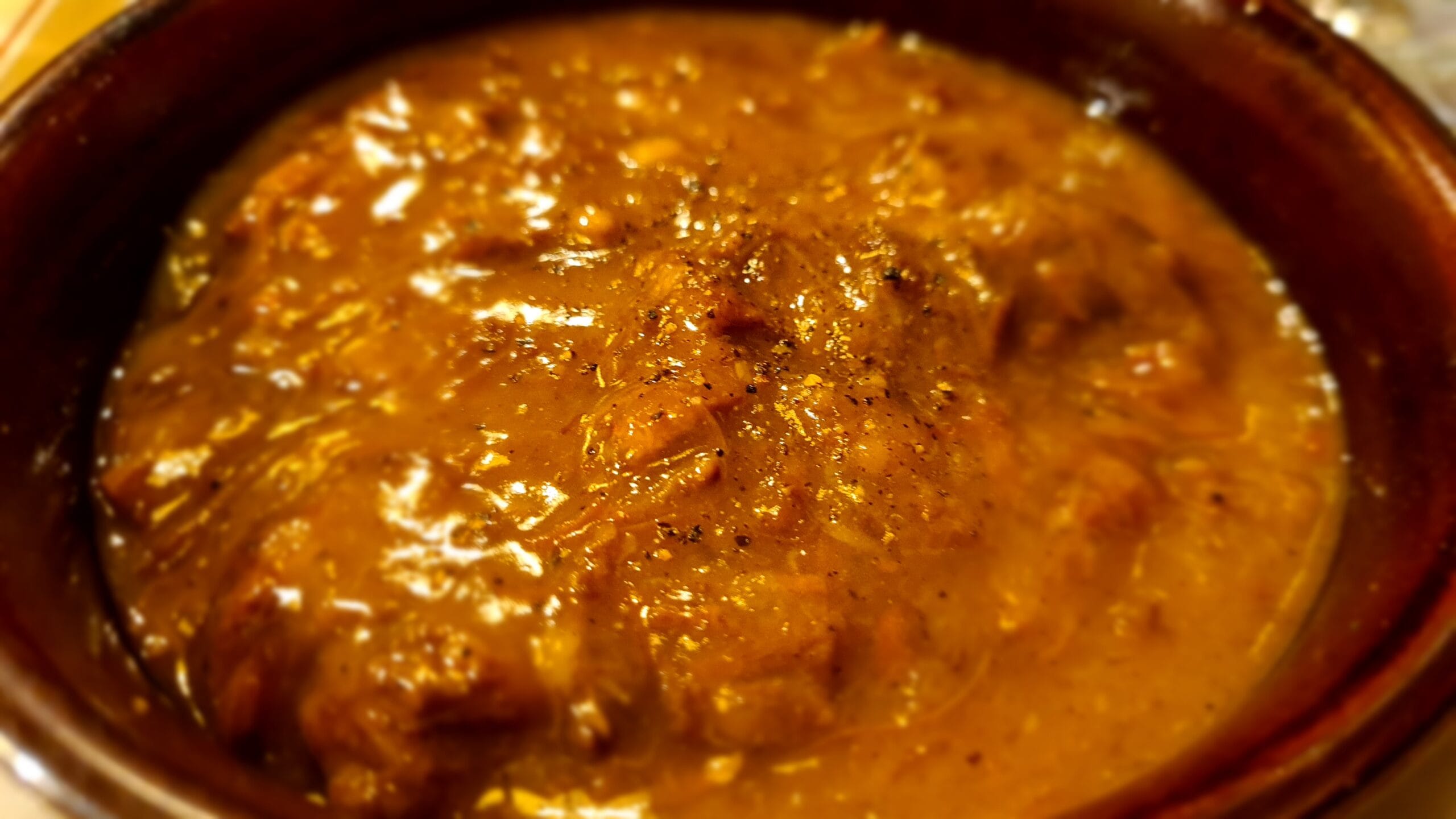
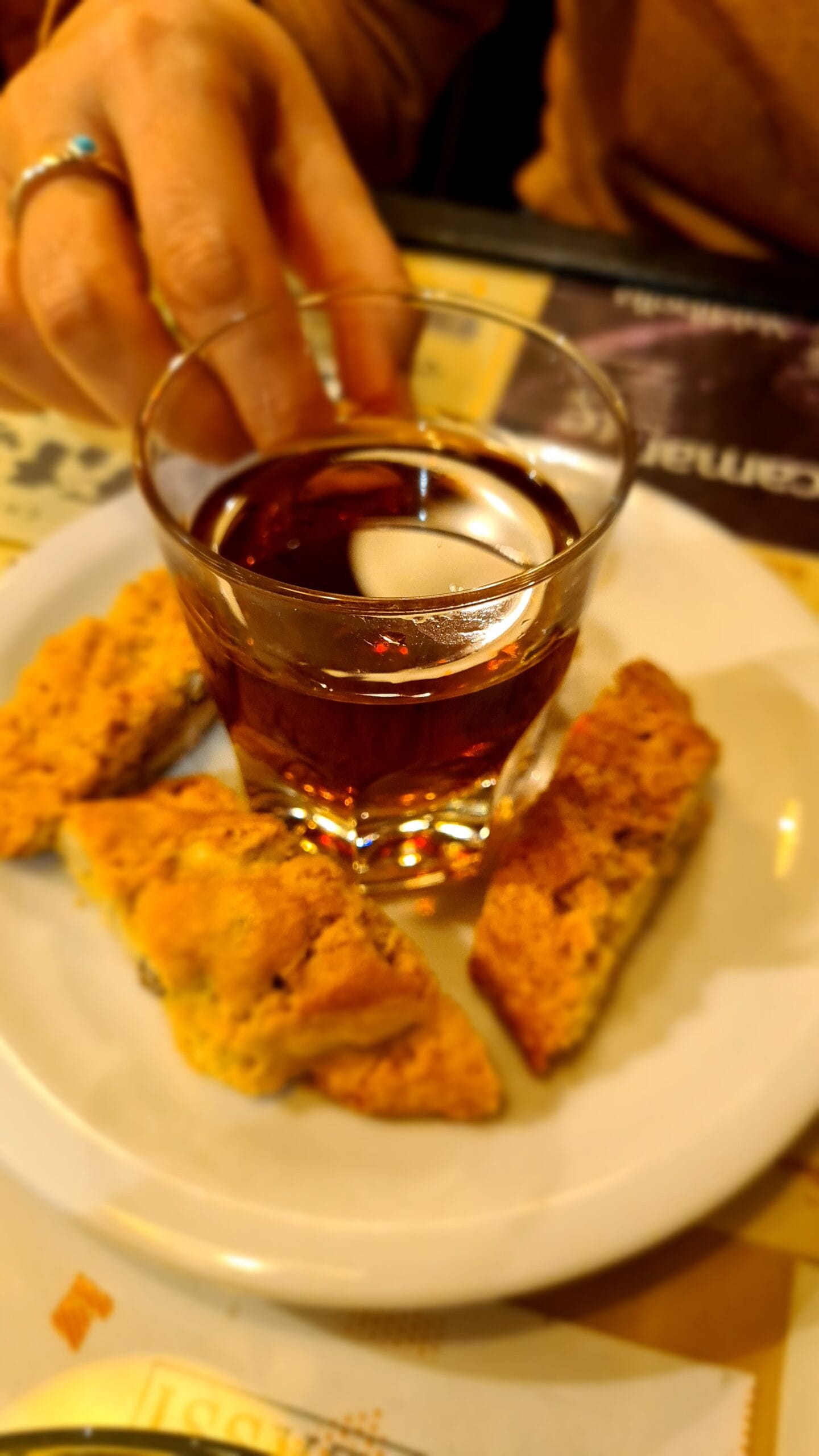 We should really have been satisfied with our hugs in a bowl, but when you know how good the food is you can’t help but have your interest piqued by the dessert menu. In this case two desserts so Italian they drive Vespas, and wear designer sunglasses indoors – Panna Cotta and Cantucci with Vin Santo. The former came with a sweet cherry compote and was possibly the best panna cotta we’ve both had, so smooth, so creamy, yet so light. You just want to literally dive in, and when it’s all gone ask for another. Vin Santo is a dessert wine traditional in Tuscany, they serve it with cantucci, the hard biscuits sometimes served with coffee. The Vin Santo alone is delightful, not too sweet but still a dessert wine, and then when you dip a perfectly baked cantucci in it with the almond nuttiness – a marriage made in heaven!
We should really have been satisfied with our hugs in a bowl, but when you know how good the food is you can’t help but have your interest piqued by the dessert menu. In this case two desserts so Italian they drive Vespas, and wear designer sunglasses indoors – Panna Cotta and Cantucci with Vin Santo. The former came with a sweet cherry compote and was possibly the best panna cotta we’ve both had, so smooth, so creamy, yet so light. You just want to literally dive in, and when it’s all gone ask for another. Vin Santo is a dessert wine traditional in Tuscany, they serve it with cantucci, the hard biscuits sometimes served with coffee. The Vin Santo alone is delightful, not too sweet but still a dessert wine, and then when you dip a perfectly baked cantucci in it with the almond nuttiness – a marriage made in heaven!
As someone who has dabbled in making sourdough cantucci, I felt like I may have been angering the Italian gods with my efforts when you taste such perfection. But the bar has been set—when I’m home, I’ll be back in the kitchen trying to recreate what we’ve tasted here.
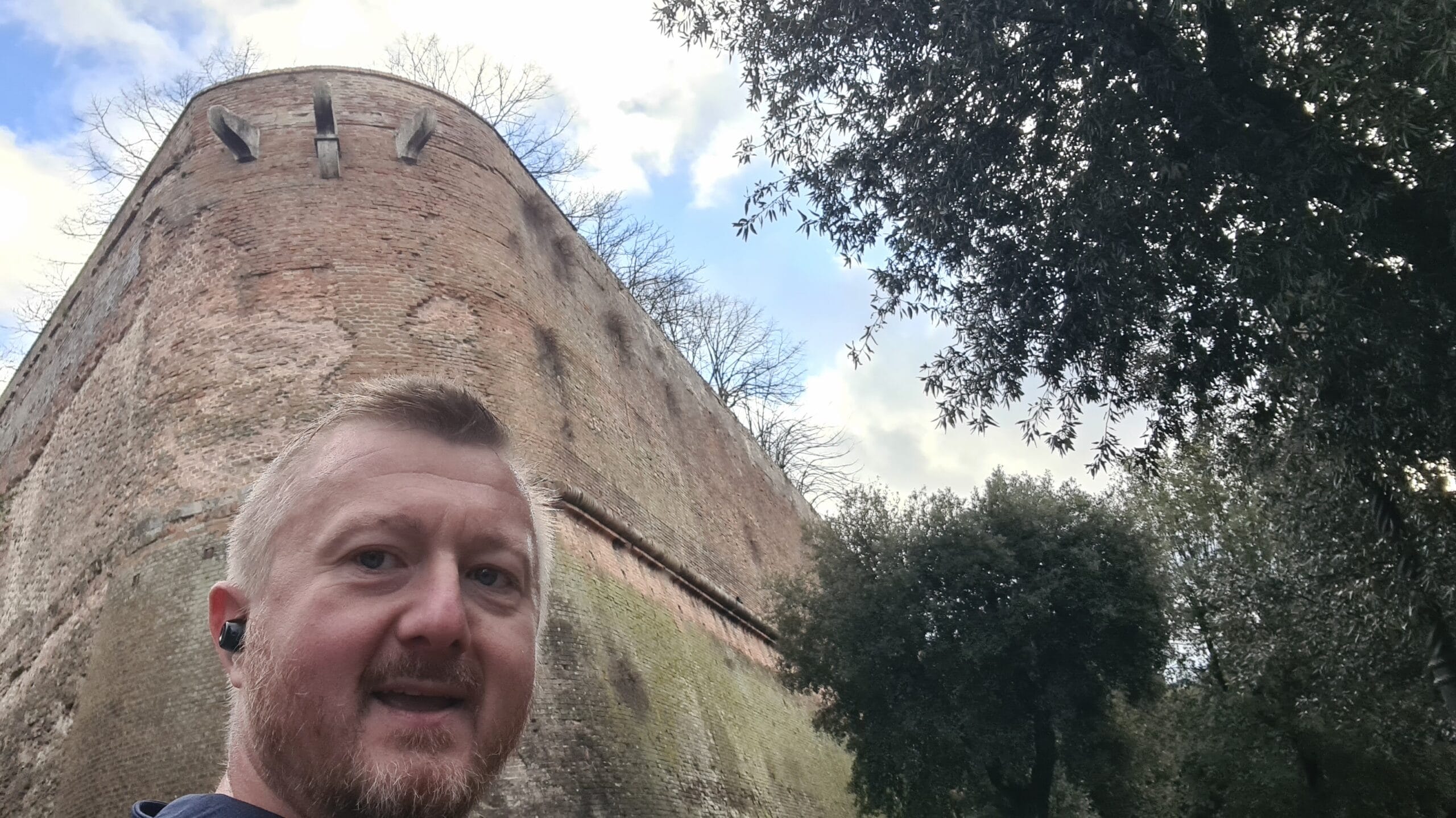
Positioned to the north of the historic centre of Siena the Fortezza Medicea overlooks the timeless skyline of Siena and the undulating Tuscan countryside, a quiet space now but if walls could tell you stories, you’d be captivated for days.
Today, following a major restoration in 1937, the fortress is a public park, with benches lining its walls and even exercise machines in the green spaces on its turrets. It is also used for festivals and concerts, is home to the Siena Jazz foundation and frequently hosts art exhibitions.
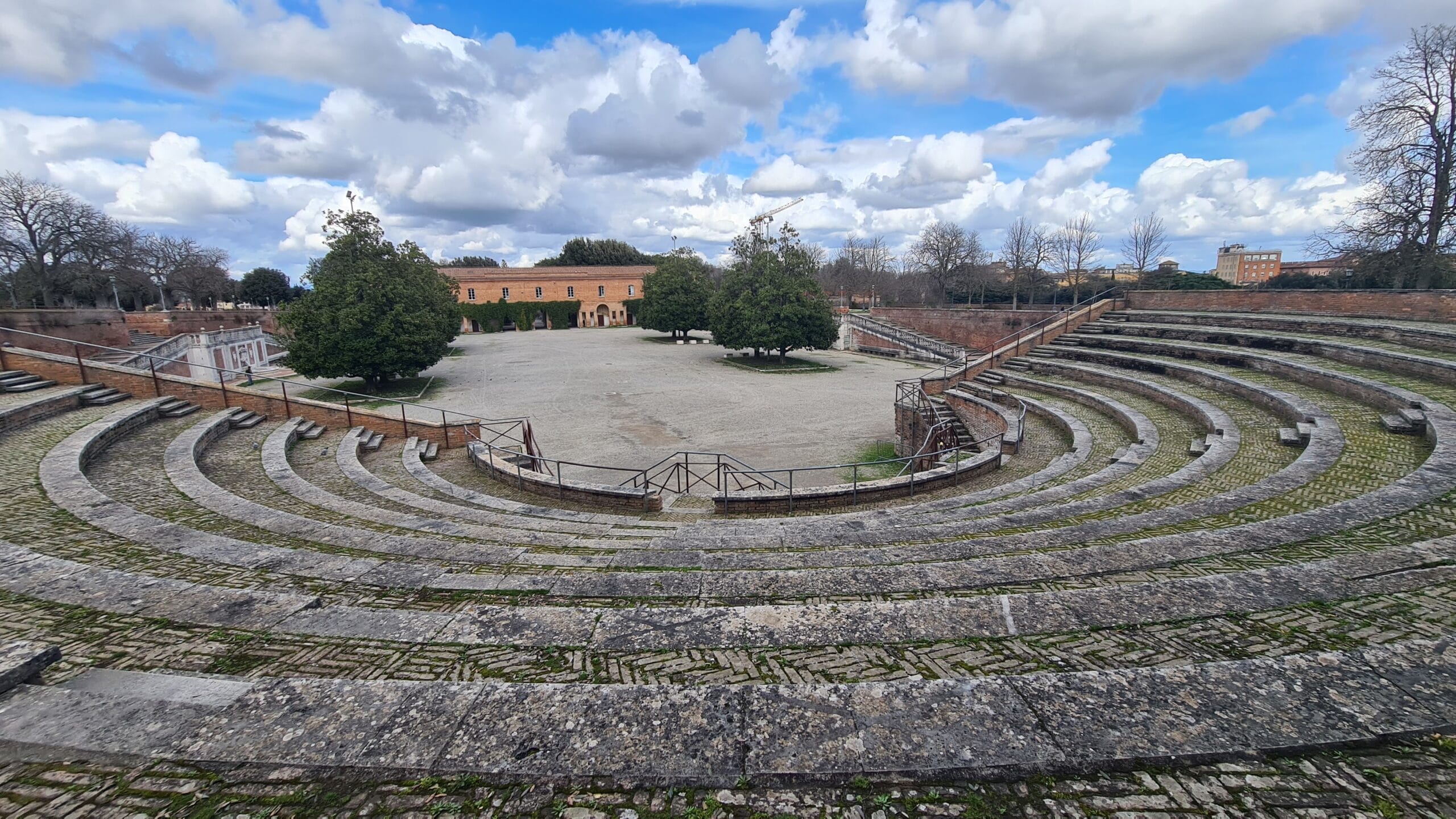
Its history however is obviously one of military use. It was built between 1561 and 1563 on the orders of Duke Cosimo. Construction of the fortress followed the Battle of Marciano which in 1554 marked the final defeat of Siena by its long-standing rival, Florence. In order to prevent any attempt by the Sienese to recover their independence, Cosimo ordered the construction of the present fortress on the site of an earlier Spanish Citadel destroyed by the Sienese in an earlier uprising.
In some ways I imagine, a prominent monument to the independence, fight and spirit of the Sienese people that such a fortress was required to keep them from rising up again.
Exploring the fortress makes for a perfect walk, with panoramic views back across the city, the duomo and rolling hills. It’s a must.

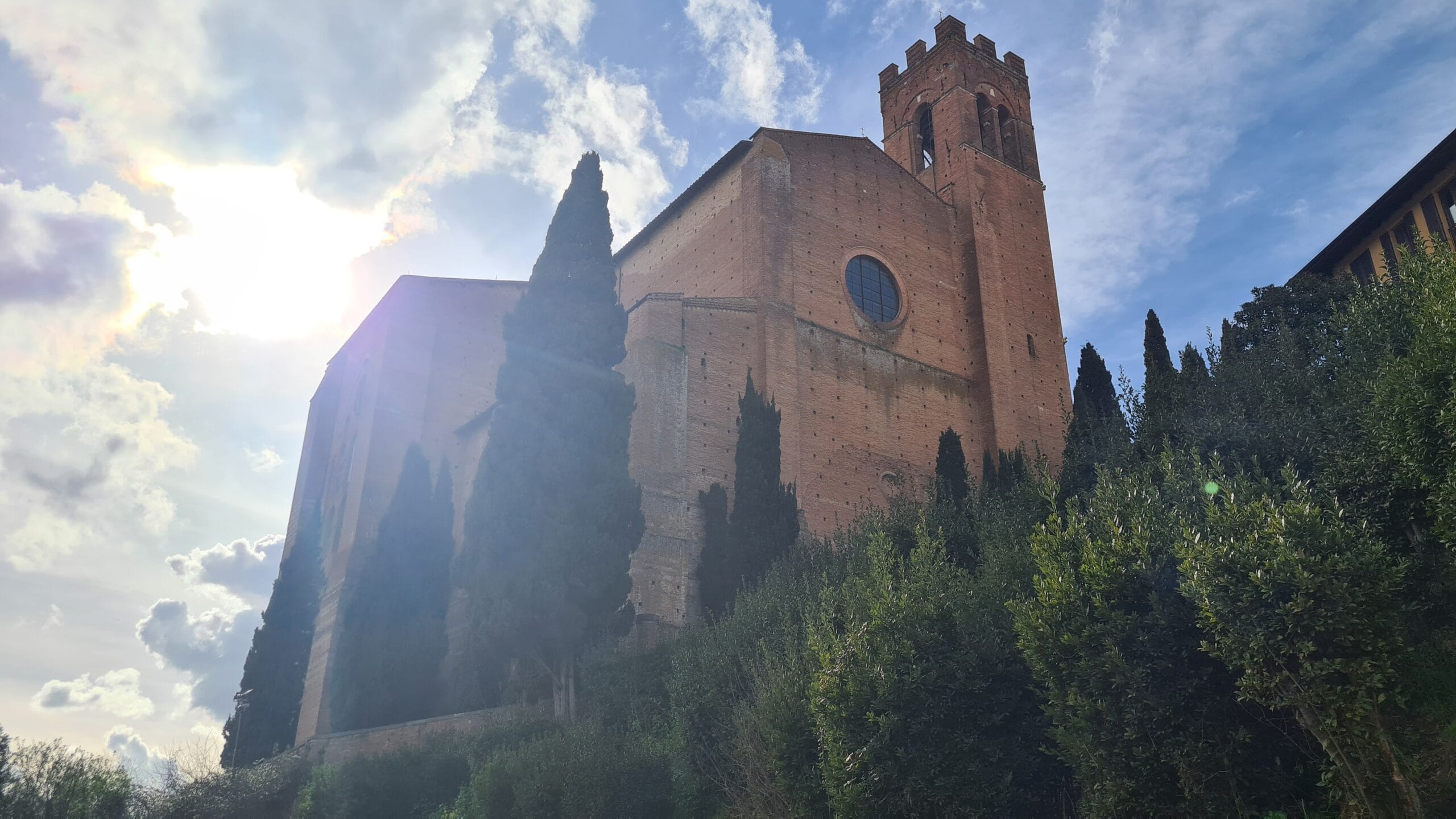
One of the most important churches in the city and a stone’s throw from Fortezza Medicea, the basilica is an example of Cistercian Gothic style. What struck us most about this church was its sheer size, big from the outside, somehow bigger from within. There are no internal columns cluttering the nave, it’s one big open space that feels easily big enough to hold an eleven a side football match.
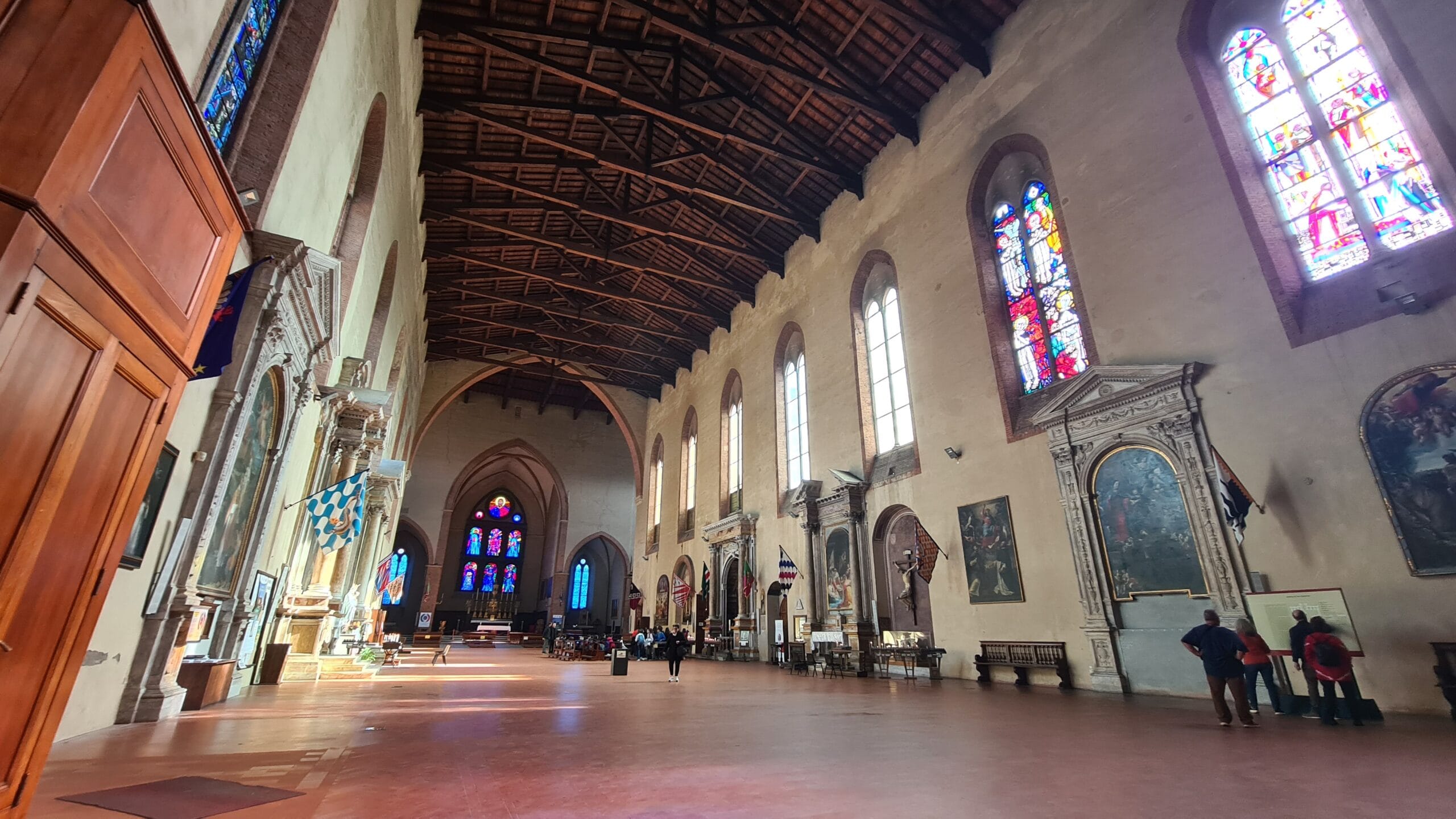
The church was built between 1226–1265, on the hill of Camporegio, which the Dominicans had received as a gift from the Malavolti family. It was enlarged in the 14th century resulting in the Gothic appearance it has now.
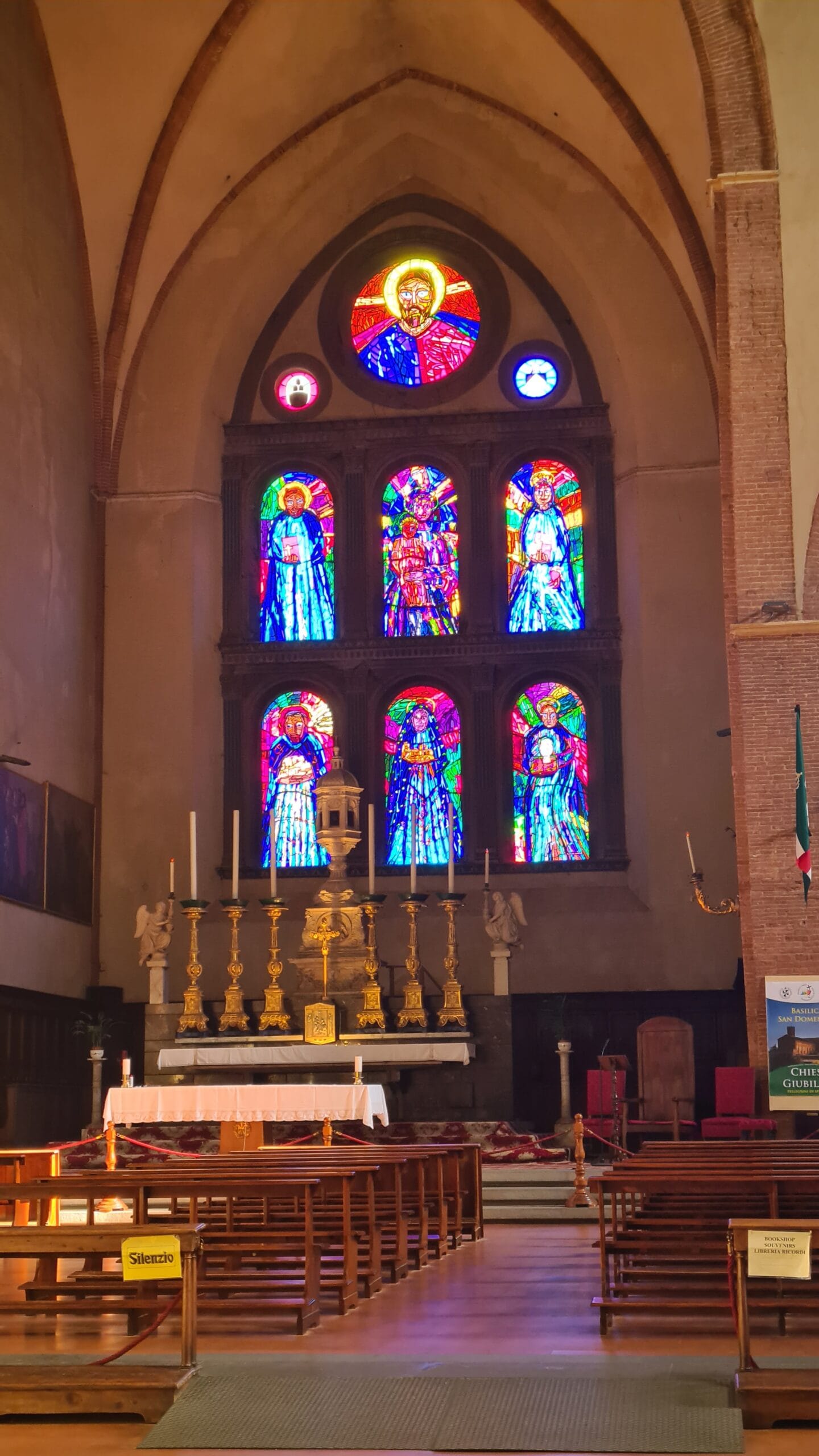 The church houses some impressive works of art, brightly coloured stained glass windows and religious relics, not least the head of St Catherine after whom the church gets its other name, Basilica Cateriniana. St Catherine or Catherine of Siena, was a Catholic mystic and pious laywoman who engaged in papal and Italian politics through extensive letter-writing and advocacy. She is revered as a saint and as a Doctor of the Church due to her extensive theological authorship. She is also considered to have influenced Italian literature.
The church houses some impressive works of art, brightly coloured stained glass windows and religious relics, not least the head of St Catherine after whom the church gets its other name, Basilica Cateriniana. St Catherine or Catherine of Siena, was a Catholic mystic and pious laywoman who engaged in papal and Italian politics through extensive letter-writing and advocacy. She is revered as a saint and as a Doctor of the Church due to her extensive theological authorship. She is also considered to have influenced Italian literature.
Born and raised in Siena, Catherine (one of 25 children born to her parents) wanted from an early age to devote herself to God, which was against the will of her parents. She was advised to signal her commitment to her parents by cutting her hair (a tactic that other female saints had used to express their resolve to remain unmarried.) This led to a protracted battle with her family, during which her family, in effect, treated her as a servant in the family home.
Eventually, her parents gave up and permitted her to live as she pleased and stay unmarried. She chose to live an active and prayerful life outside of a convent’s walls, following the model of the Dominicans. Catherine devoted herself to helping the sick and incarcerated of Siena. With her help in the Hospital of Santa Maria della Scala and within the neighborhood that she was living, Catherine’s acts of charity became well known. Her reputation of holiness eventually led to her involvement in politics and hearings with the pope.
Catherine ranks high among the mystics and spiritual writers of the Catholic Church. She remains a greatly respected figure for her spiritual writings, and political boldness to “speak truth to power”, with it being out of the ordinary for a woman in her time period to have had such influence in politics and on world history.
The story of a trailblazer if ever I’ve heard one.
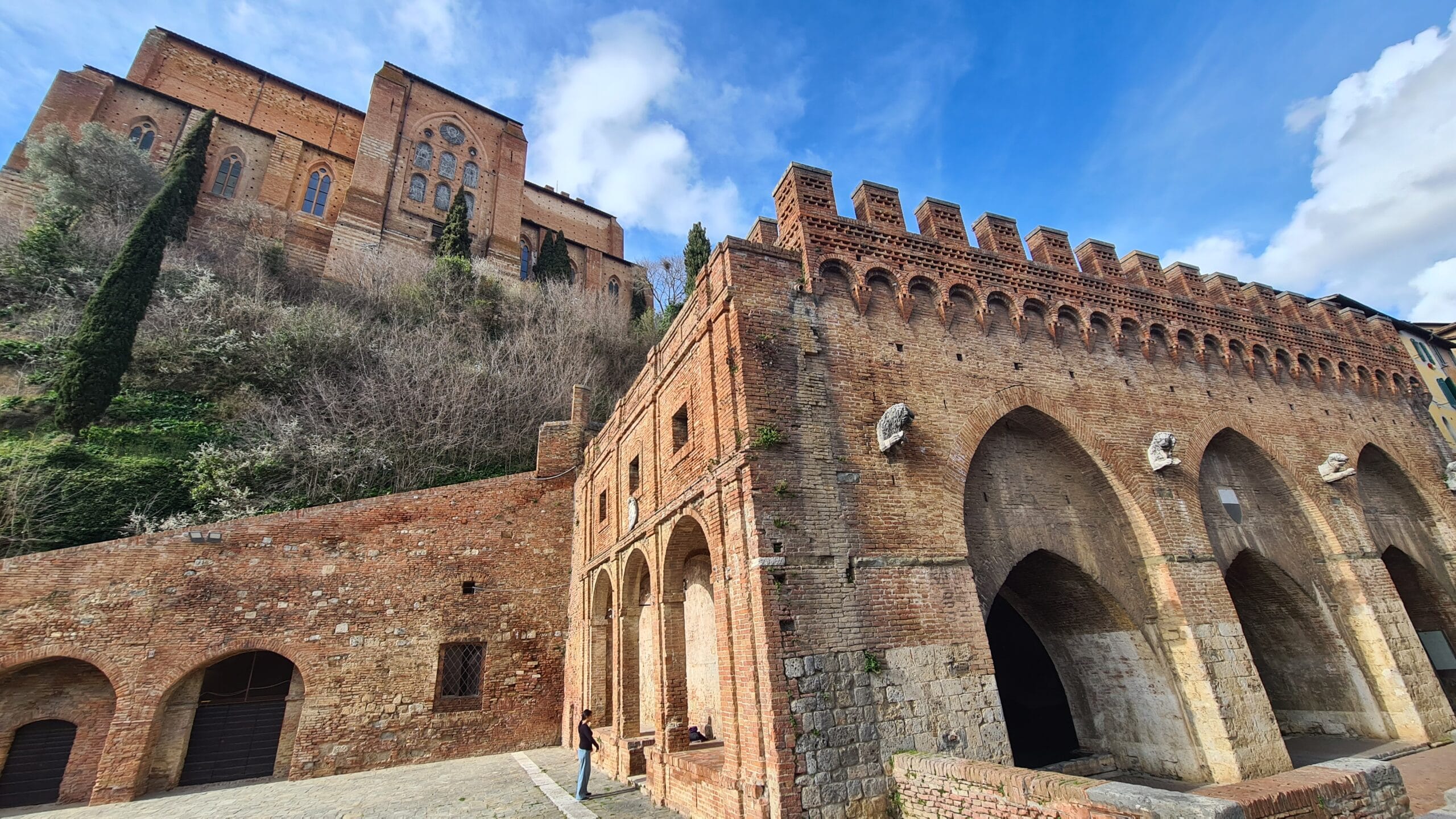
Just below the basilica, and steeped in its own history, sits a very different kind of landmark, a unique fountain, Fontanina Contrada dell’Oca. Each district (contrada) of Siena has its own fountain, this one belongs to the Contrada of Oca (Goose).
The fountain was built by the Guild of the Wool-makers. The first mention of a fountain was in 1081, and documents speak of enlargement by Bellamino in 1193, and finally rebuilt in its present form in 1246. The fountain is cited by Dante Alighieri in the “Divine Comedy”.
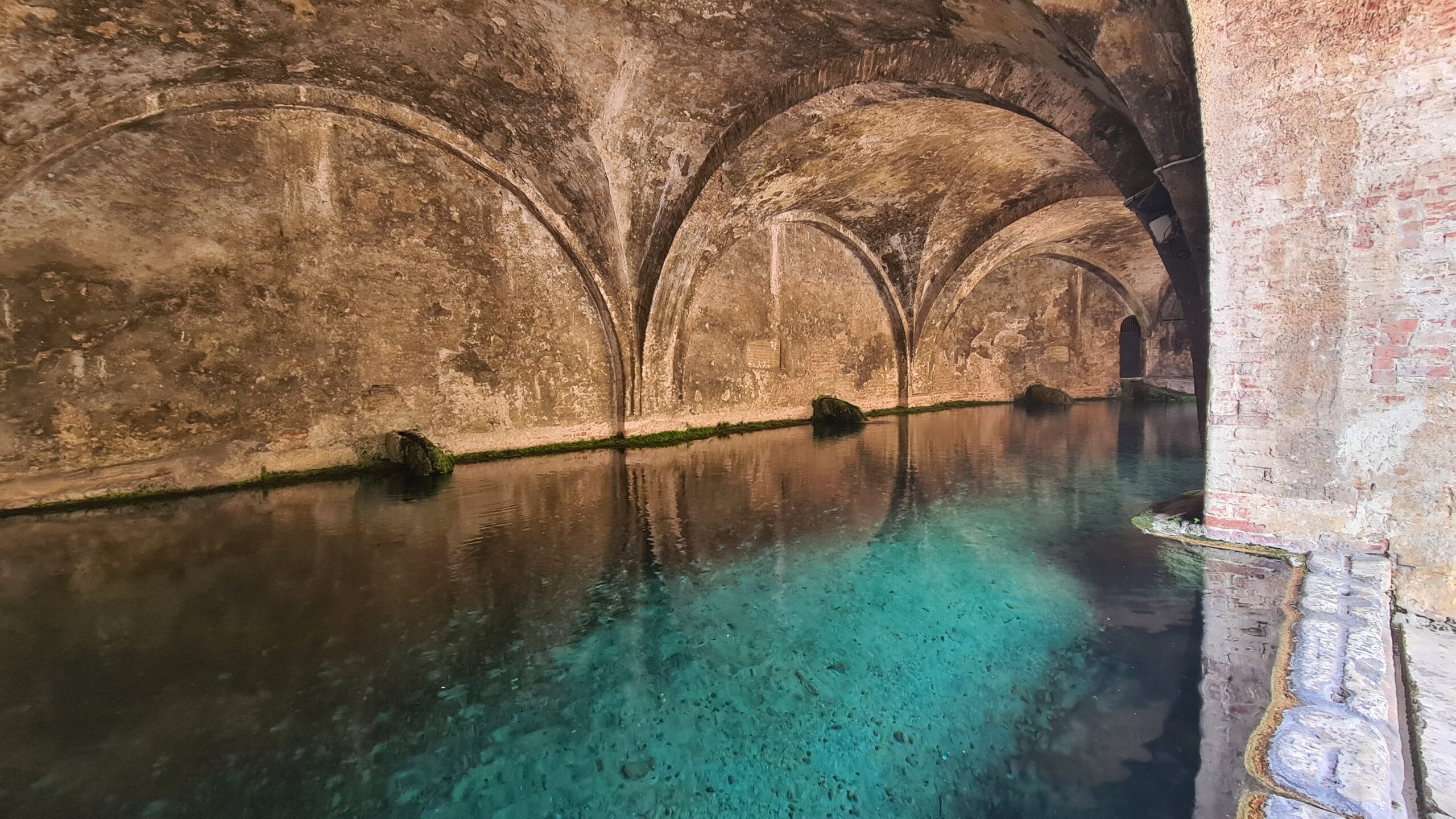
The fountain features three Gothic arches and is supplied by aqueducts, it resembles a bath house more than what we think of as a fountain. This is due to its multiple use: to get drinking water for people of the district and their animals, and to wash clothes, especially the textiles made by the Guild of Wool-makers.
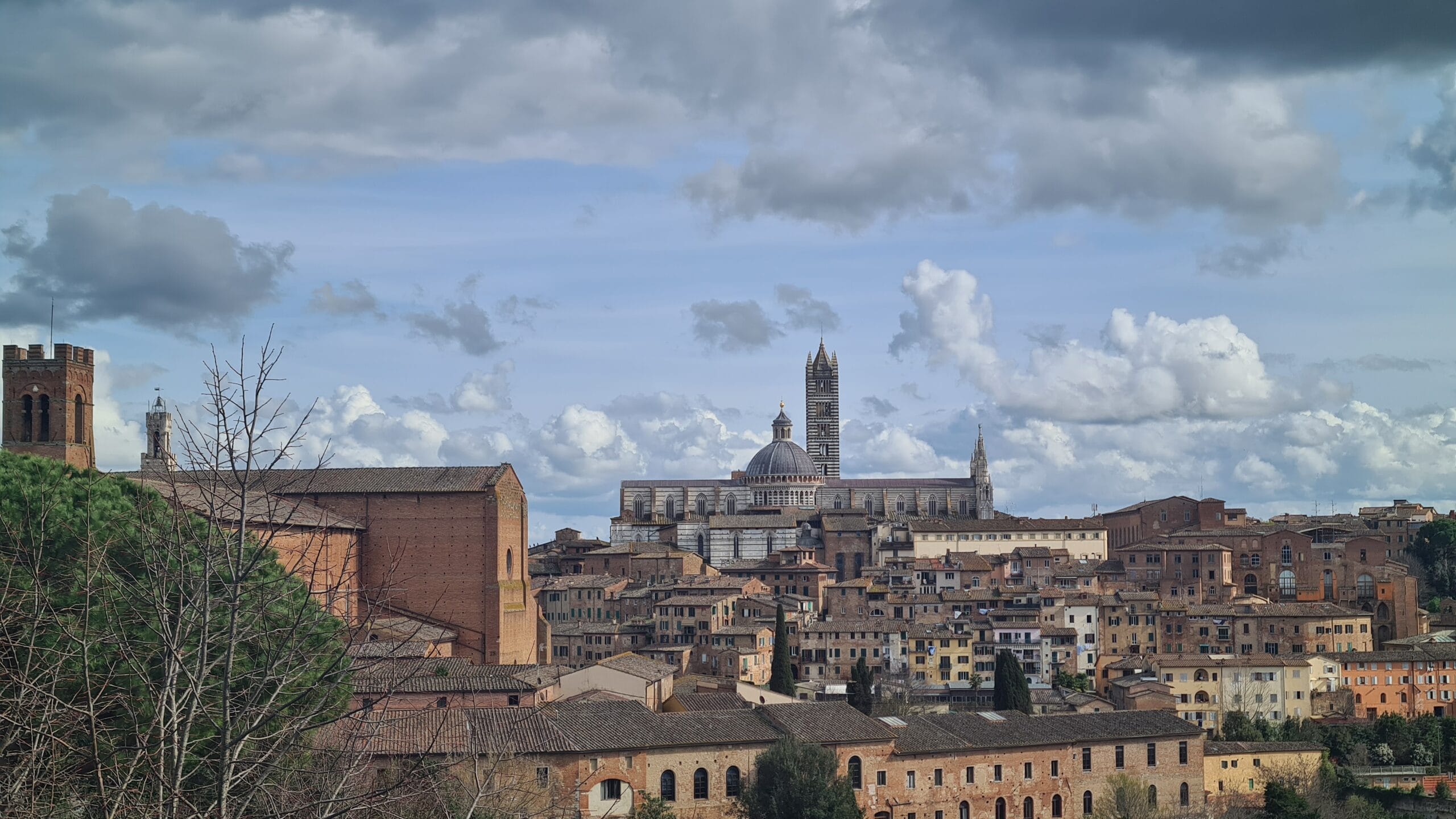
We spent time wandering the streets of Siena, losing our way on several occasions, and were rewarded for doing so. As well as the beauty of the city there are some stunning views out across Tuscany.
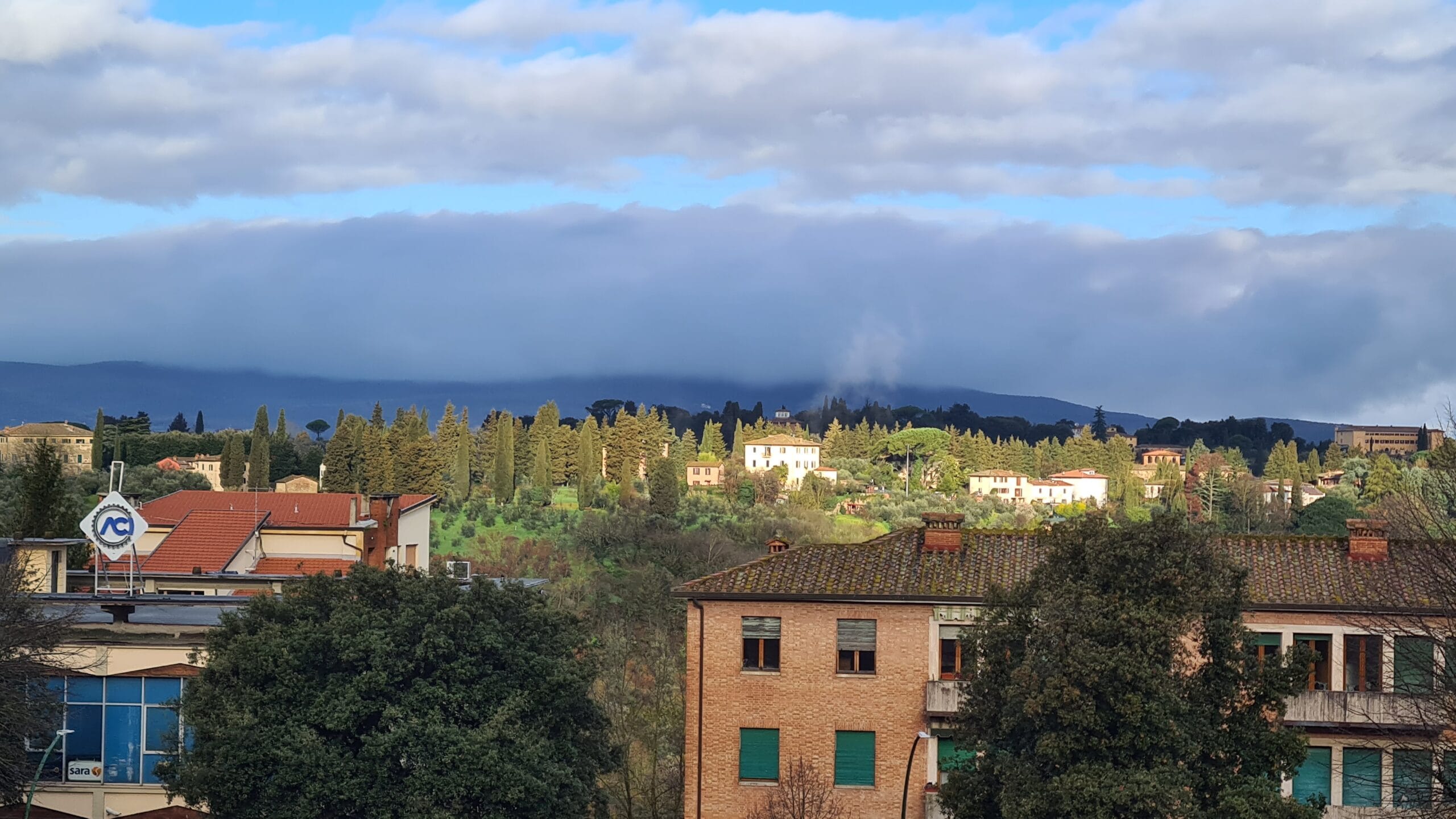
We’d already taken in the view from our room and the Duomo’s panoramic platform, but Siena kept offering more.
On one wander behind and below the Palazzo Publicca, we stumbled upon the Piazza del Mercato, from which you get lovely views down one of the valleys. Well worth a visit.
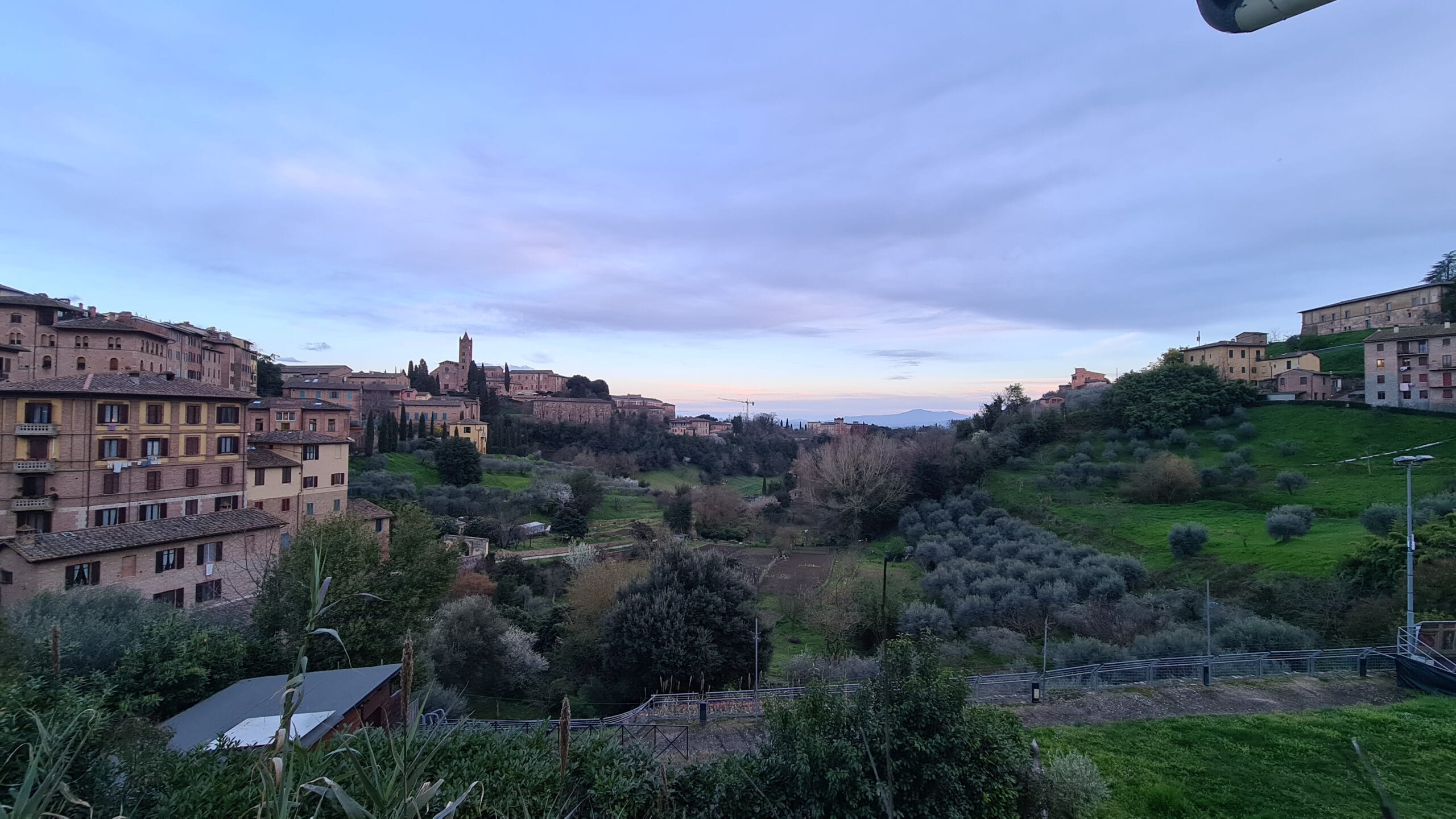
Next to the Conservatorio Statale di Musica “Rinaldo Franci”, there’s another great view across the valley. When we visited, some locals had gathered with a couple of take away beers to see in the end of the day and a little sunset.
We only had 3 days, 2 mornings of which Zoe was working. We left Siena with plenty more to see and experience in the future. It’s a city steeped in history, tradition, and slow pleasures — and one that lingers long after you leave.
Our recommendation would be to take your time with Siena, wander, seek out a viewpoint or two, enjoy some slow food, sit in the viewing galleries, don’t just get drawn to the main attractions.
Get lost in Siena’s charm. But be warned, you may never want to find your way out.
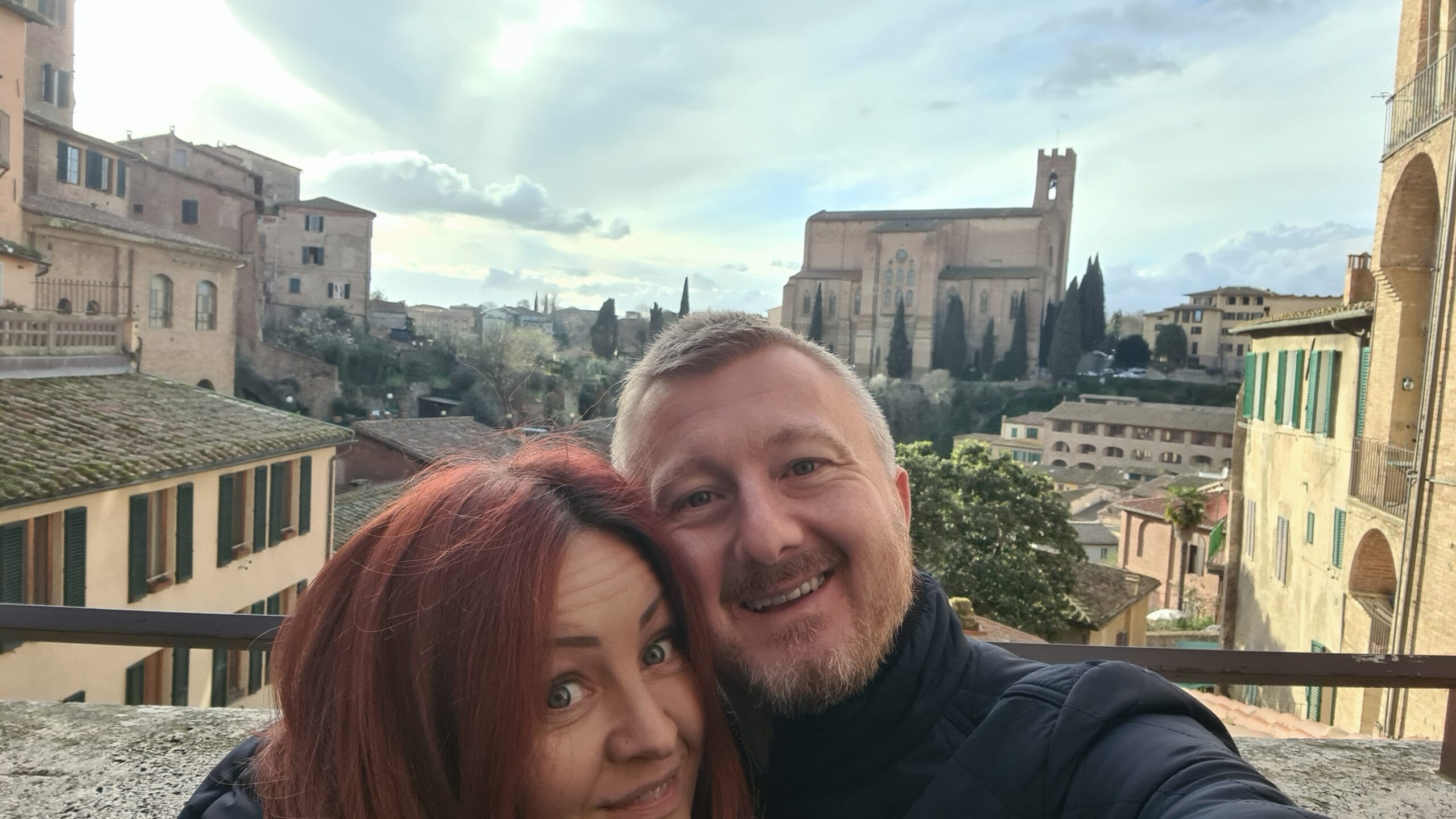
Follow us on instagram @a2z.wander

A2Z Wander | Our Blog A Rainy Arrival (and a Slight Hangover) Lamezia Terme almost didn’t get its own blog post. There’s only so many
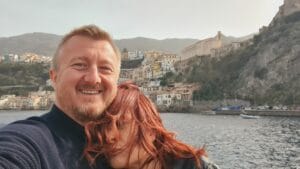
A2Z Wander | Our Blog A short coastal train ride punctuated by dramatic thunderclaps brought us further down into Calabria to a town called Scilla.
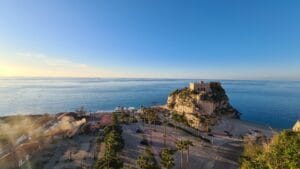
A2Z Wander | Our Blog This is quite the introduction to the town of Tropea… This is the view from Belvedere Piazza del Cannone in

A2Z Wander | Our Blog Three weeks into the trip, and we were finally swapping wheels for waves, boarding our first boat along the coast

A2Z Wander | Our Blog With Sorrento in our rear-view mirror and the sea glittering to our right, we eased into the Amalfi Coast Drive,

A2Z Wander | Our Blog Naples left its indelible mark on us. We were sad to be leaving with so much still unexplored. But, if